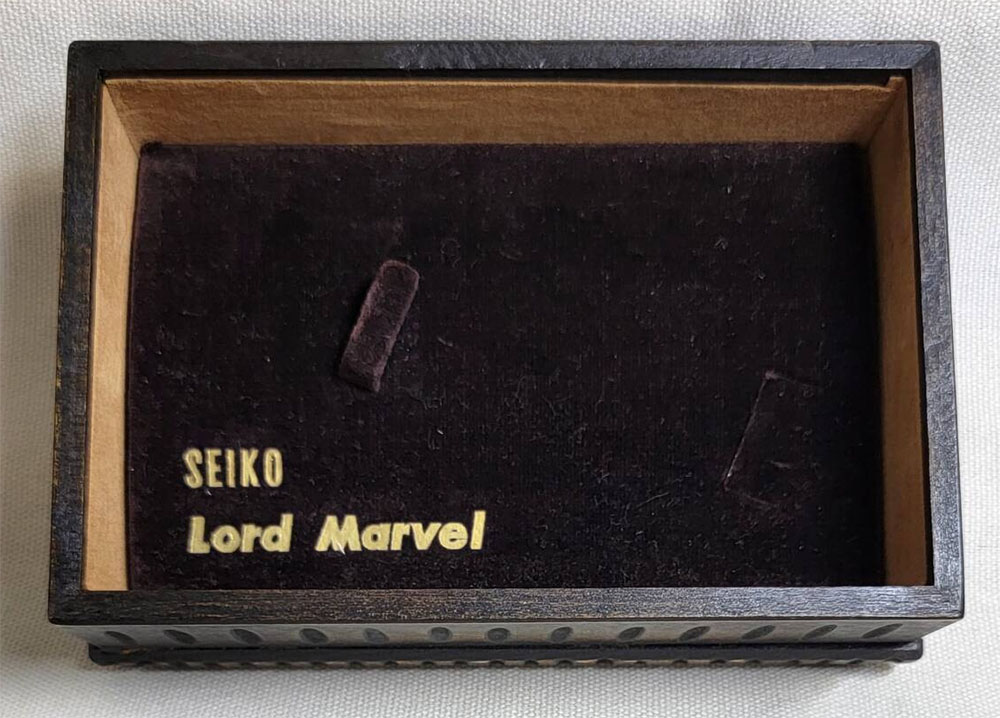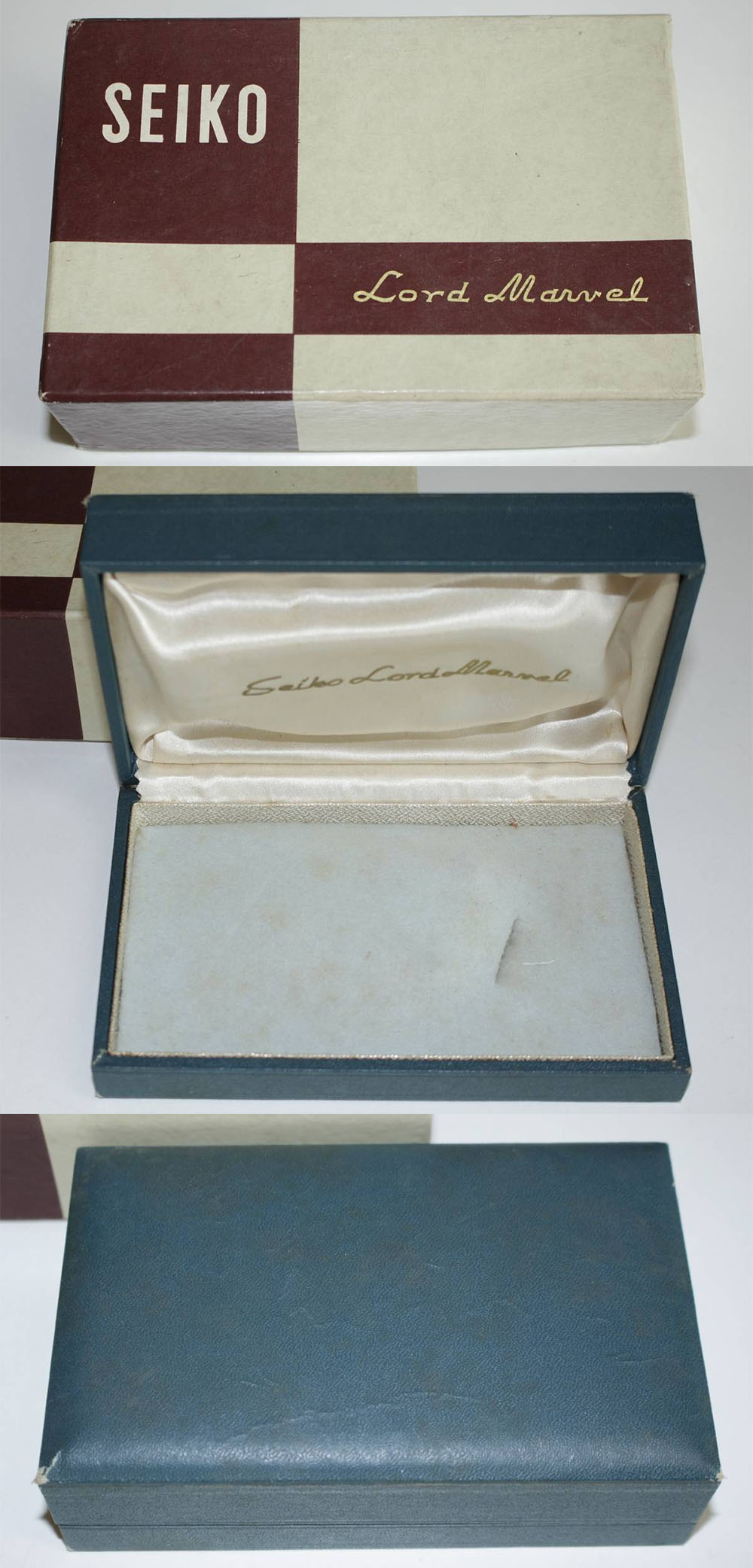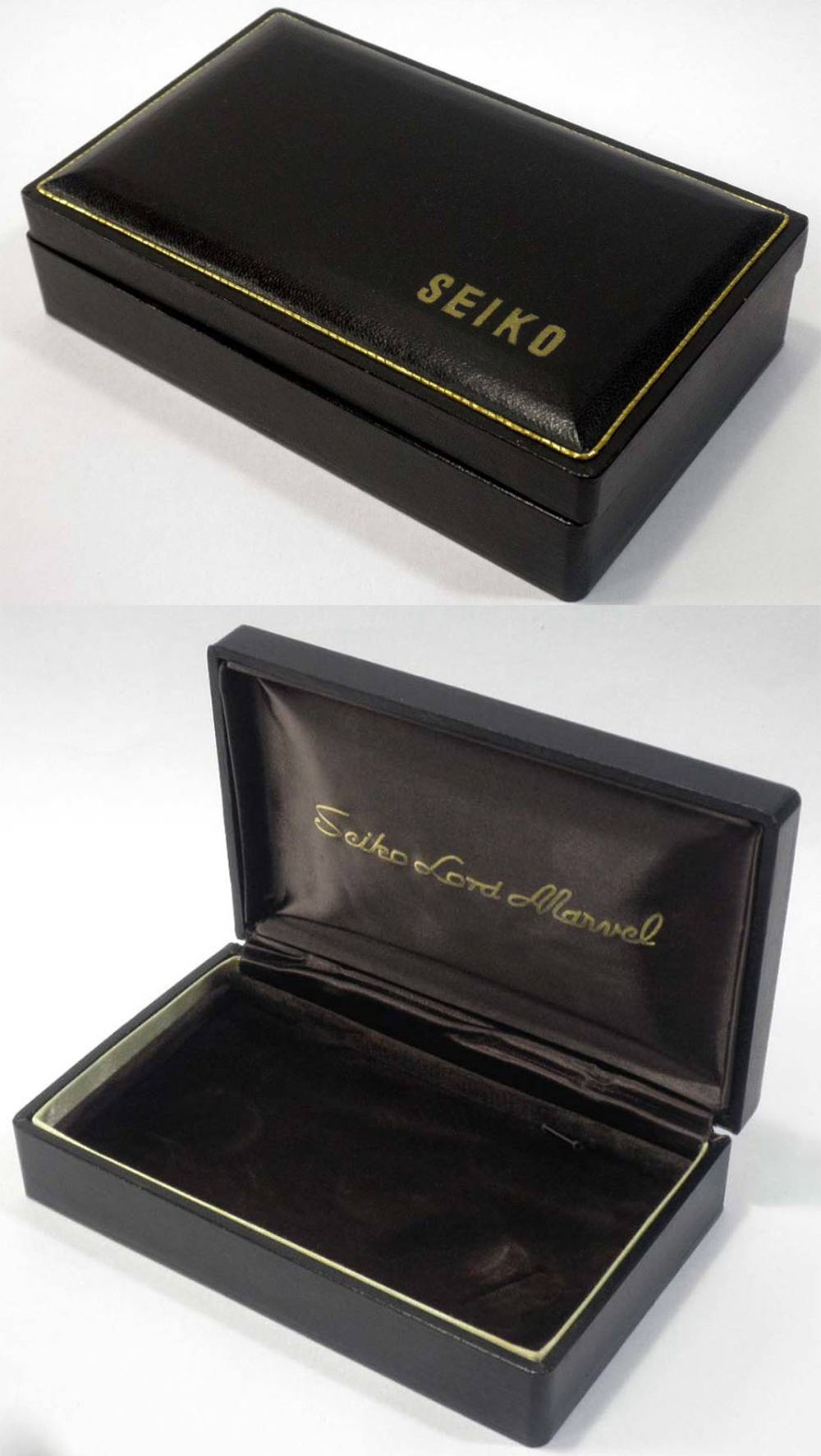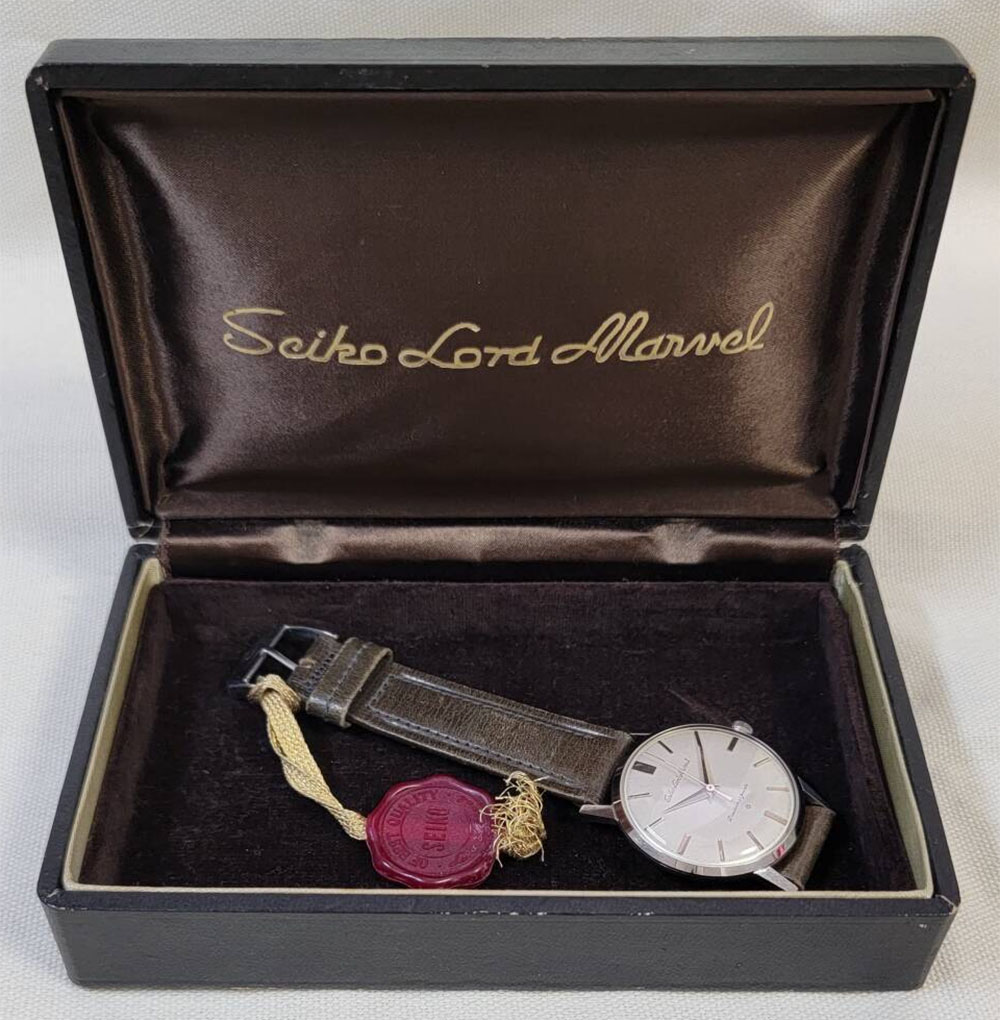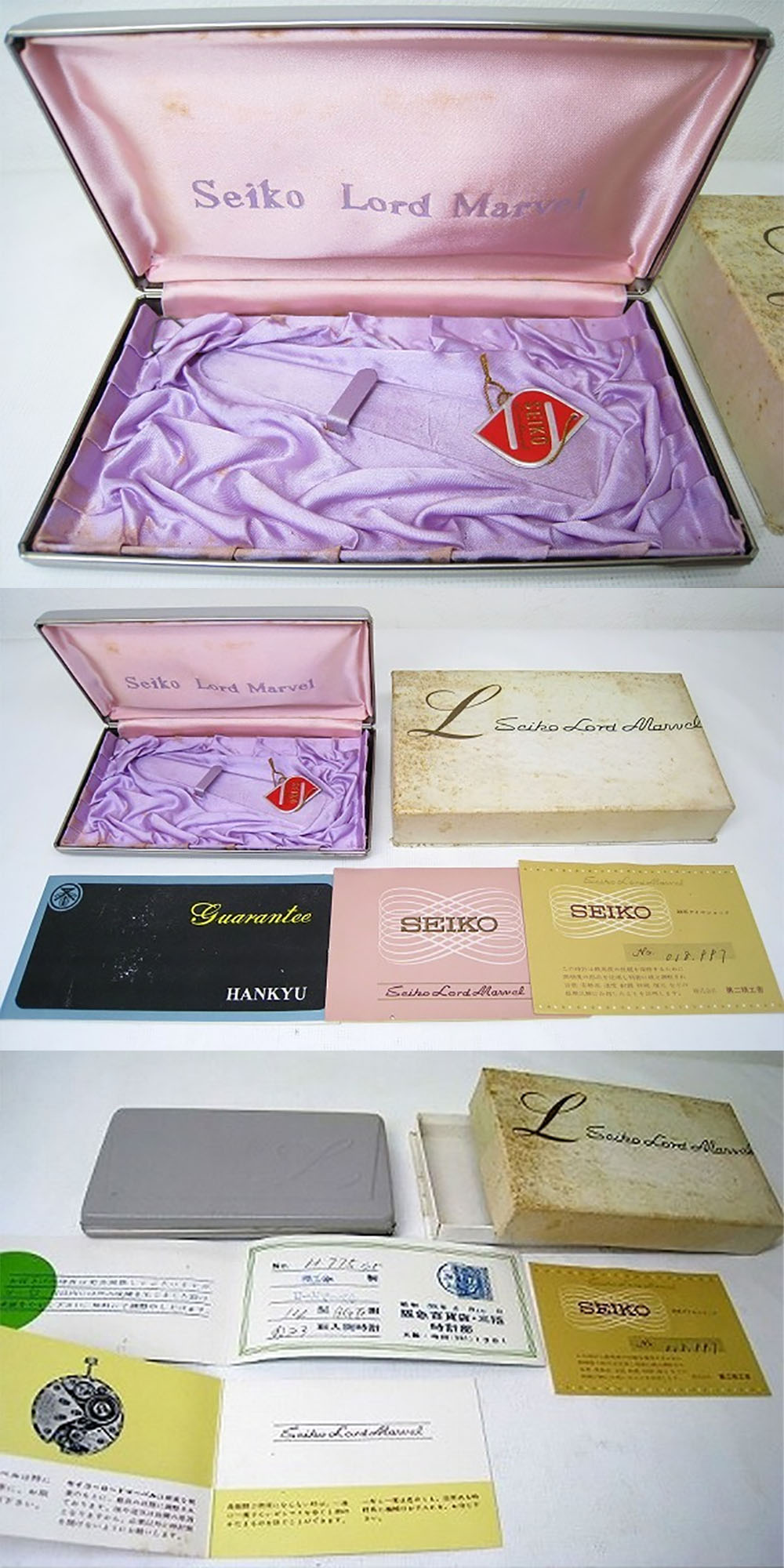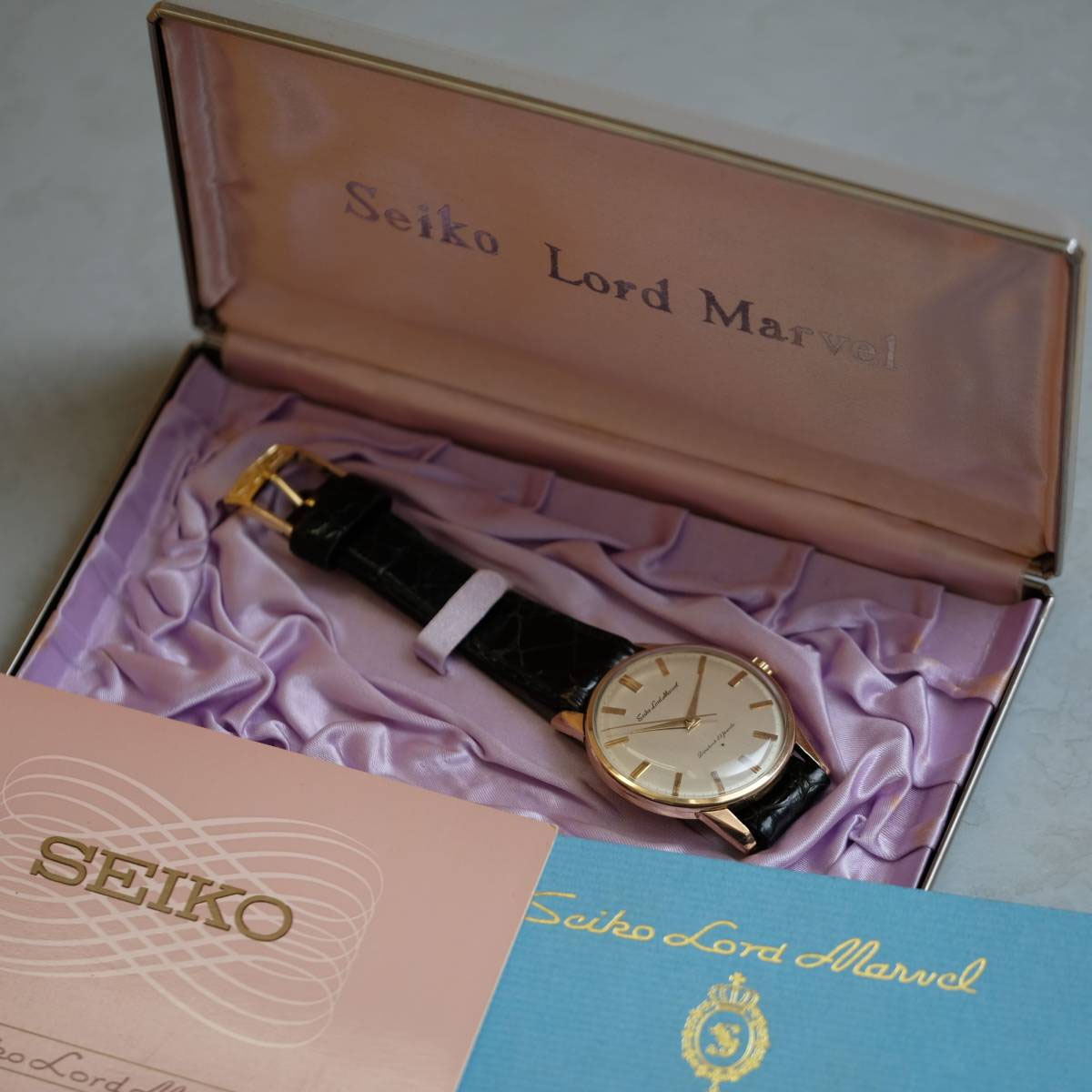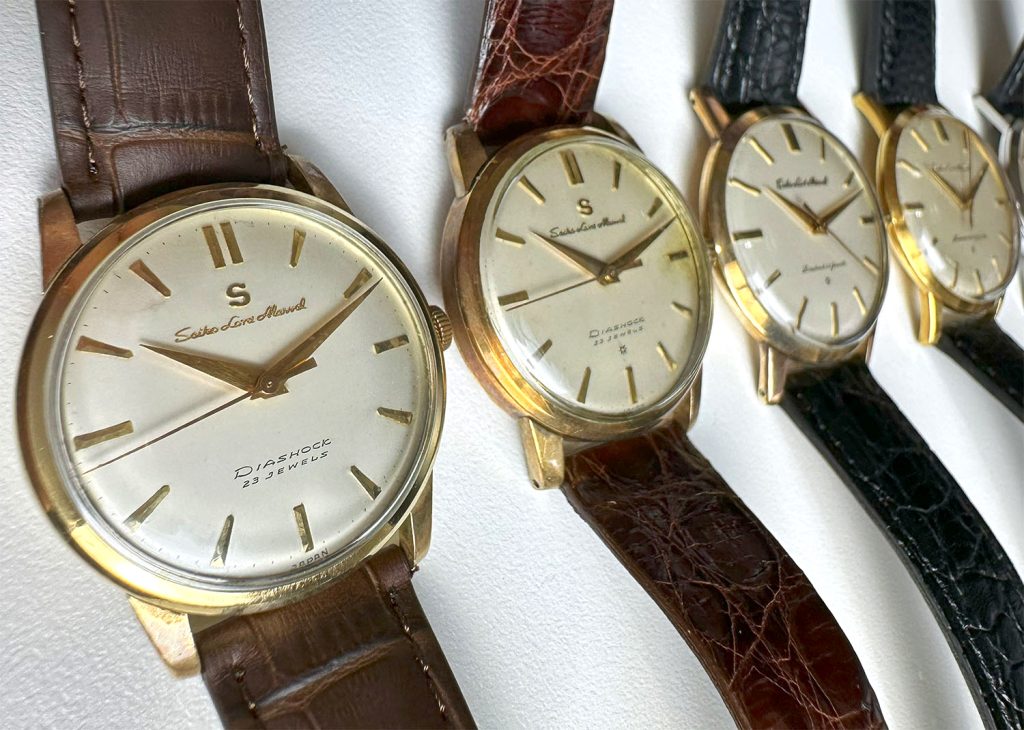
Introduced in 1958, the Lord Marvel is widely regarded as the first true luxury Japanese wristwatch and represents a fundamental chapter in Seiko’s history.
As its name suggests, the origins of this model trace back to the Seiko Marvel, the first wristwatch entirely developed in-house by the Japanese manufacturer. Introduced in 1956, the Marvel’s movement proved to be highly reliable, robust, and accurate, becoming the foundation for numerous subsequent models.
The Lord Marvel was introduced as a luxury version of the Marvel, featuring a higher jewel count movement, improved and meticulously finished with great attention to detail. However, it retained the same fundamental architecture, including the same 25.6 mm diameter and 4.4 mm thickness.
Therefore, the Lord Marvel did not replace the Marvel but complemented it as a higher-tier alternative, becoming the flagship product within Seiko’s wristwatch lineup.
This collector’s guide, which I compiled by consulting period documentation and analyzing numerous examples and their respective serial numbers, covers all models considered part of the first generation of Lord Marvel watches, introduced between 1958 and the early 1960s, which feature the older case codes.
To facilitate easy reference, I have listed all models under consideration in the following table. The serial dates provided are indicative of their production periods.
| Case Code | Materials | Serials Analyzed |
|---|---|---|
| 14056 | Stainless Steel | From April 1958 to May 1959 |
| 14057 | 14k Gold Filled | From May 1958 to April 1959 |
| J14038 | Stainless Steel | From August 1959 to May 1960 |
| J14039 | 14k Gold Filled | From September 1959 to August 1960 |
| J14050 | 18k Gold | From August 1959 to August 1962 |
| J14068 | 14k Gold Filled | From April 1960 to September 1961 |
| 15023 | Stainless Steel 14k Gold Filled 18k Gold | From October 1961 to February 1965 |
| 15027 | Stainless Steel 14k Gold Filled 18k Gold | From January 1962 to October 1963 |
The Launch of the First Lord Marvel
The Seiko Lord Marvel was introduced in the August 1958 issue of Seiko News, a publication sent exclusively to authorized Seiko retailers.
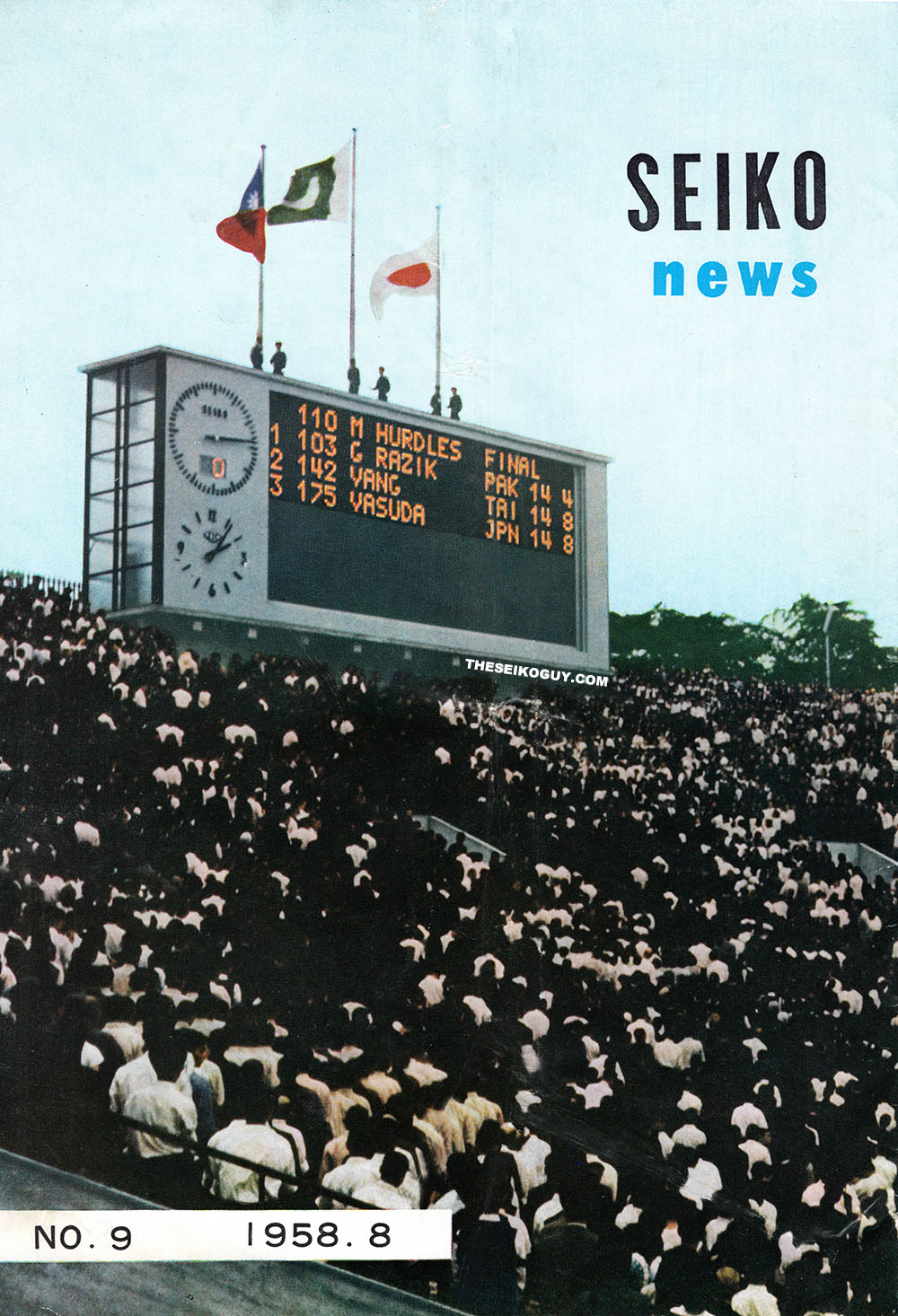
At the start of this volume, it is shown among the new releases. The description highlights that the Lord Marvel has 23 jewels, is available with a Stainless Steel or AGF (All Gold Filled) case, and the movement features the newly introduced DiaShock system.
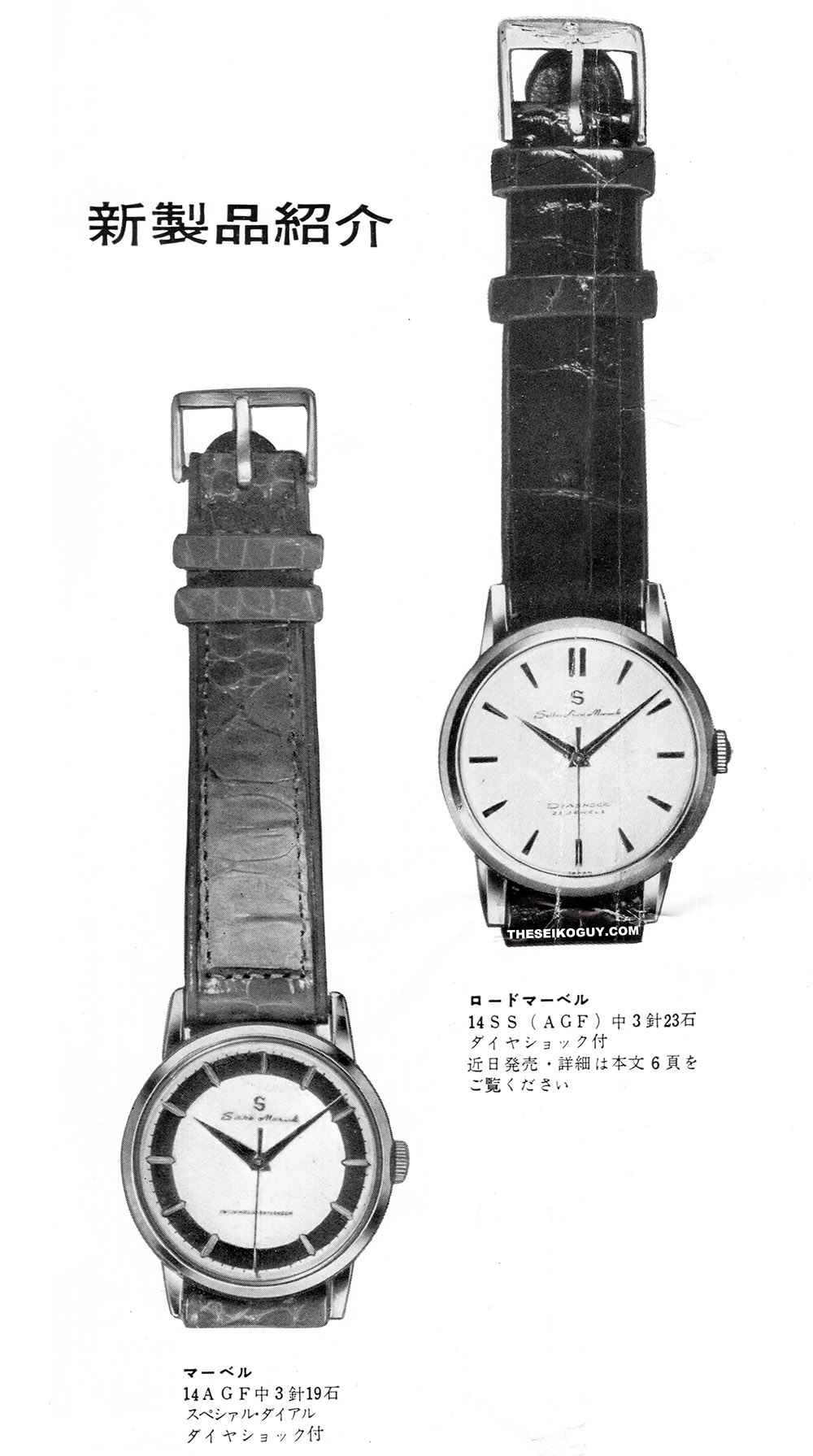
In this first illustration, you can also see the buckle of the leather strap. It should be noted that back then there was not much consistency in the buckles and straps used, and this was almost certainly not the only type of buckle associated with the early Lord Marvel.
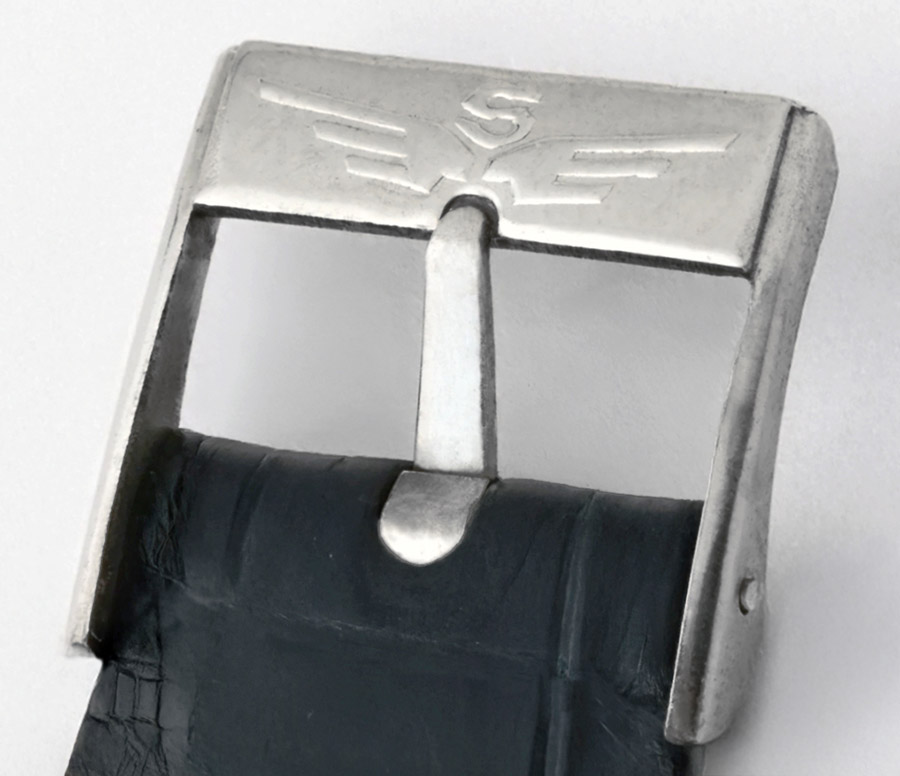
The following pages of Seiko News provide more details about the new model and the characteristics of its hand-wound movement.
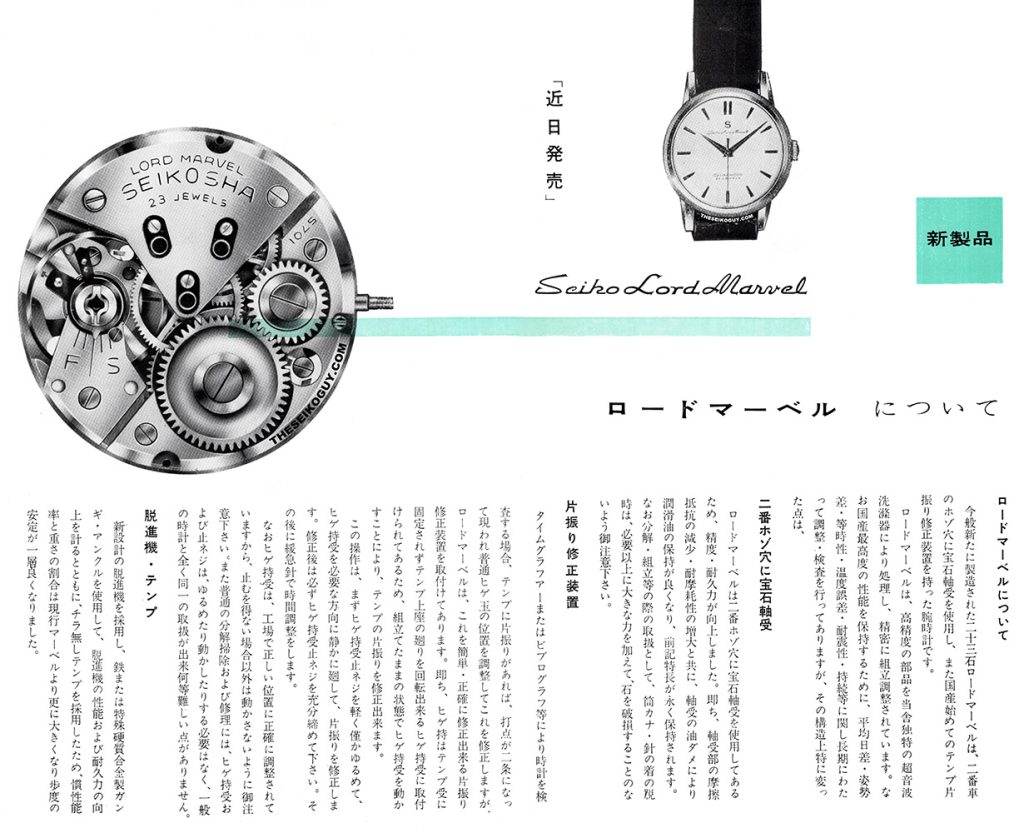
“The new 23-jewel Lord Marvel uses a jeweled bearing in the second-wheel pivot hole and is the first Japanese wristwatch to feature a device for correcting irregular balance-wheel oscillation.
The Lord Marvel is assembled and precisely regulated, with its high-precision parts treated by an exclusive ultrasonic cleaner. Additionally, to maintain its position as a top performer among domestic production watches, extensive long-term adjustments and tests have been carried out regarding average daily error, positional error, isochronism, temperature error, shock resistance, longevity, and more.
The unique structural features are:
Jeweled bearing in the second-wheel pivot hole
Because the Lord Marvel uses a jeweled bearing in the second-wheel pivot hole, both accuracy and durability are improved. This means the friction resistance in the bearing area is reduced, wear resistance is increased, and the lubricant retention is enhanced thanks to the bearing’s oil reservoir, preserving these advantages over a longer period of time. Also, during procedures like removing and installing the cannon pinion and hands, please be careful not to apply excessive force to avoid damaging the jewels.
Irregular oscillation correction device
When examining the watch on a timegrapher or vibrograph, if there is irregular balance-wheel oscillation, the signals appear as two lines, and typically, this is corrected by adjusting the regulator carrier. However, the Lord Marvel is equipped with an irregular oscillation correction device that allows you to correct it easily and precisely. Since the balance-spring carrier is not fixed directly to the balance bridge but is instead mounted on a support that can rotate around the upper balance bridge, you can correct any irregular oscillation by moving this carrier support without disassembling the watch.
To do this, first slightly loosen the carrier support screw, gently rotate the support in the direction needed to correct the irregular oscillation. After the adjustment, be sure to tighten the carrier support screw firmly. Then, regulate the time using the fine adjustment device.
Please note that the carrier support has been carefully adjusted to the correct position at the factory, so avoid moving it unless absolutely necessary. Also, for routine cleaning and repairs, you do not need to loosen or move the carrier support or its screw; the watch can be serviced exactly like a standard model without any difficulties.
Escapement and balance
By adopting a new escapement design and using escape wheels and pallets made of iron or special high-hardness alloys, we have improved both performance and durability of the escapement. Furthermore, by employing a stud-less balance (no regulator arm), the ratio of moment of inertia to weight has increased further compared to the current Marvel, thus improving timekeeping stability even more.”
Lord Marvel 14056 and 14057
The first Lord Marvel watches released to the market were offered in two case variations: stainless steel with case code 14056, and 14k Gold Filled with case code 14057.
The stainless steel version retailed for 9,800 yen, while the Gold Filled version was priced at 12,800 yen, a considerably high price at the time.
The Gold Filled case featured an 80-micron thick layer of 14-karat gold, making it thicker and more durable than standard gold plating. The same type of 14k Gold Filled case was also used for the first Grand Seiko, introduced two years later, in 1960.
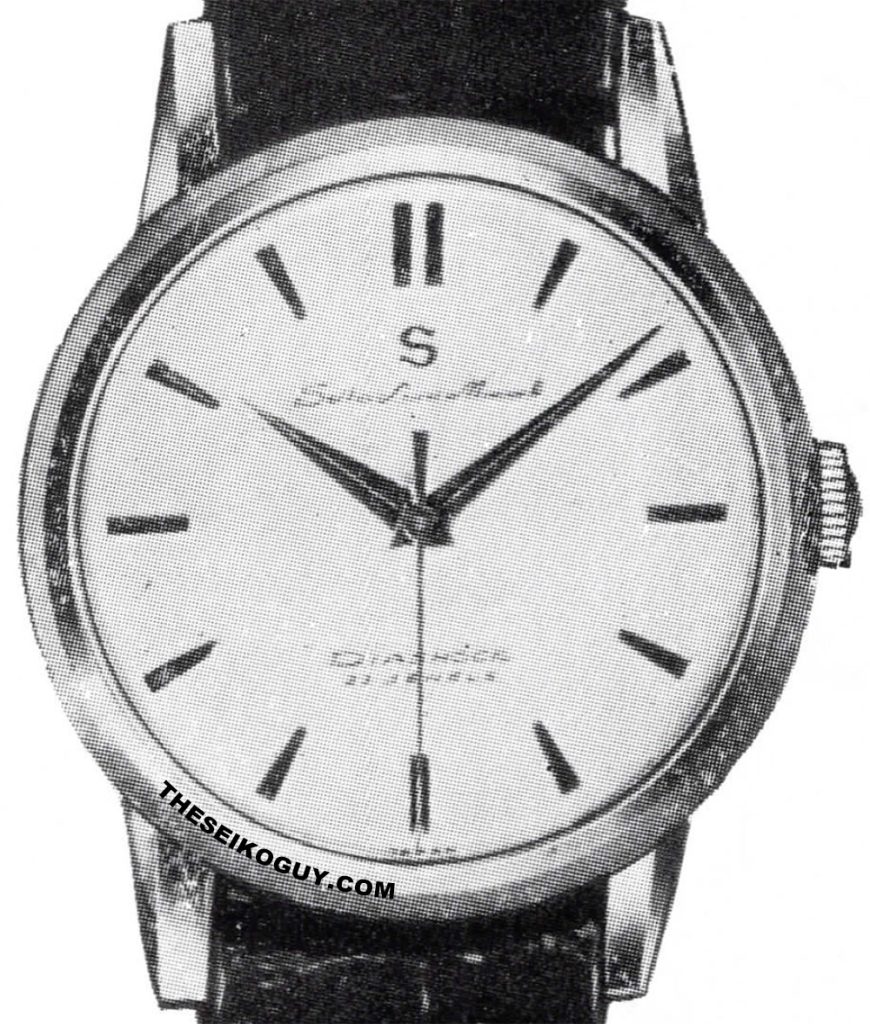
Although produced for just over a year, Lord Marvel models 14056 and 14057 can be found in several configurations.
The earliest examples produced, highly sought-after by collectors, feature an applied “S” logo positioned above the engraved “Seiko Lord Marvel” text.
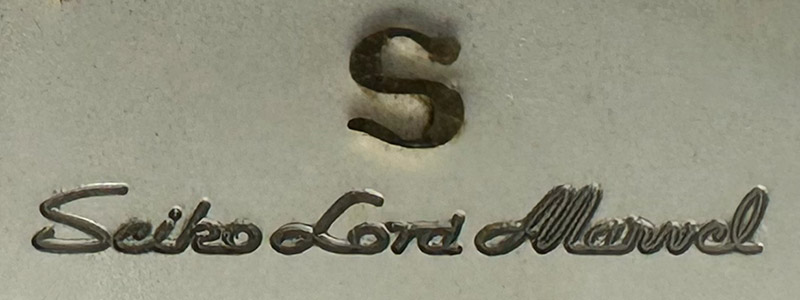
Among these, the very first examples lack the “SD” (Special Dial) logo at 6 o’clock, similar to the watch illustrated in Seiko News.
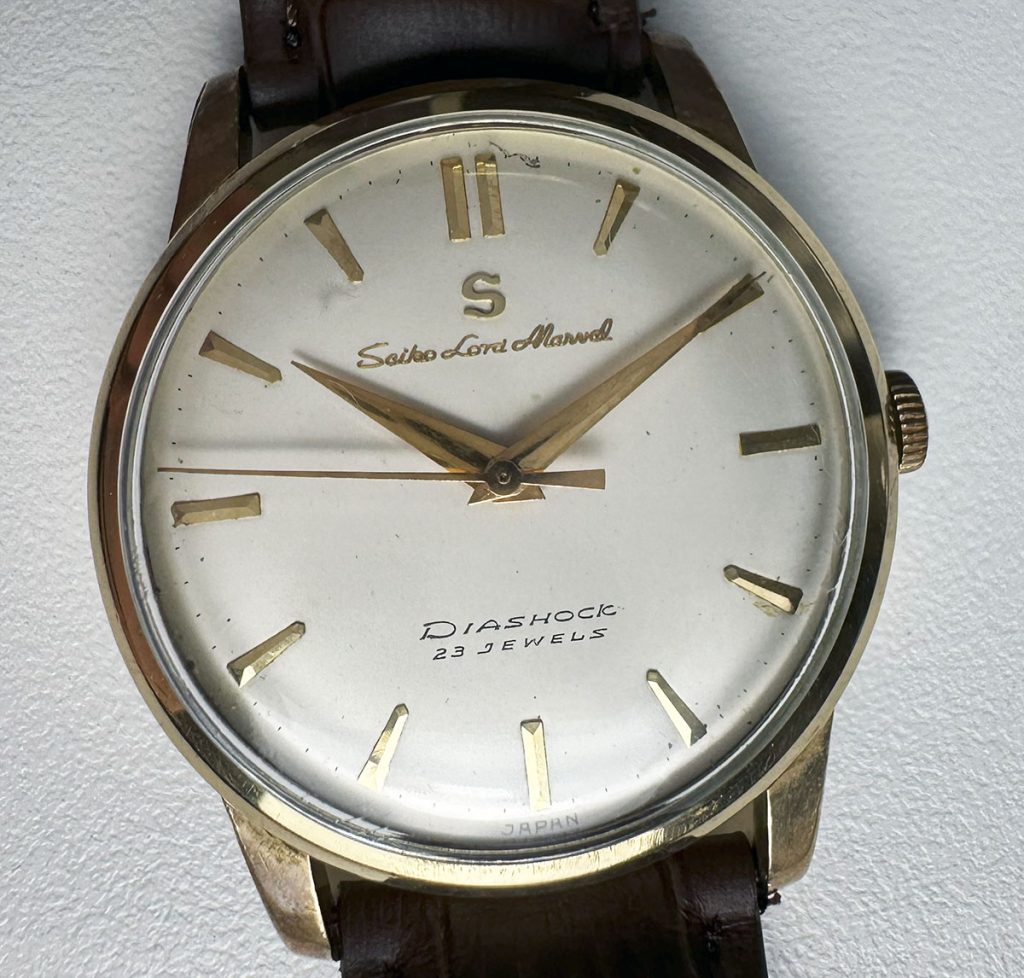
Another distinguishing feature of these earliest examples is the double marker at 12 o’clock, which has a wider gap compared to subsequent productions.
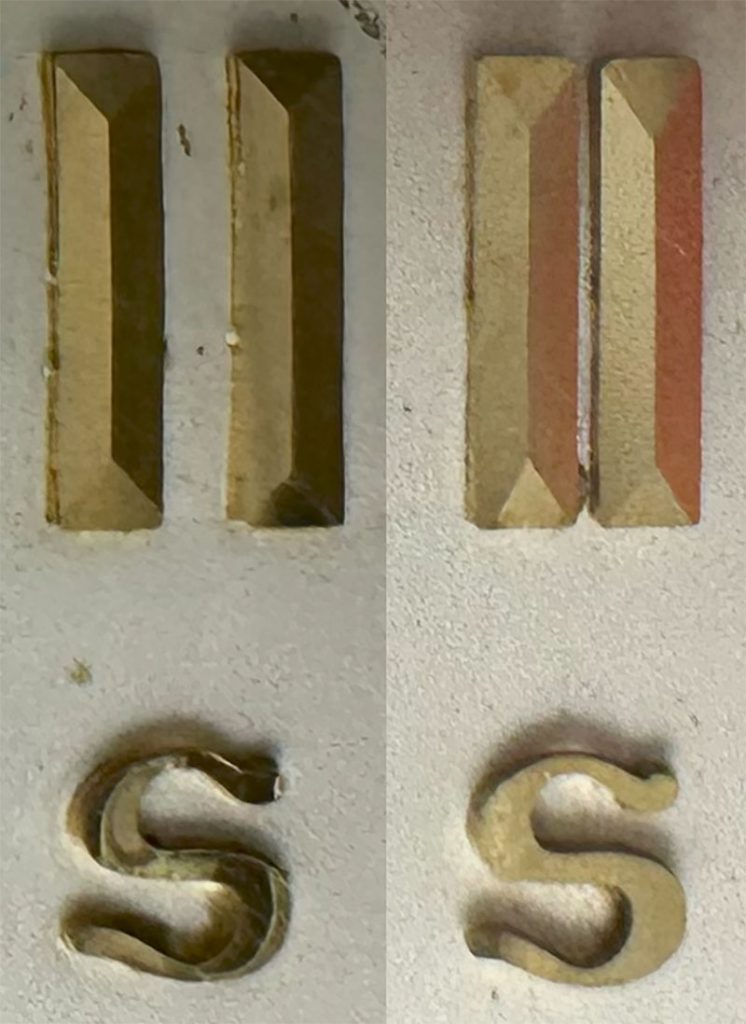
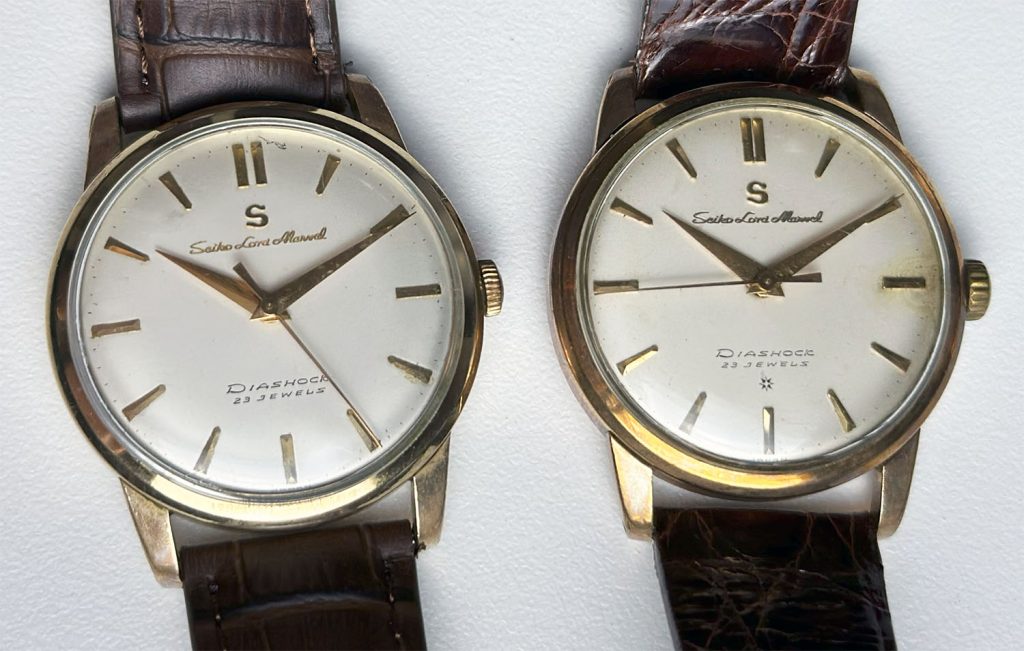
Examining serial numbers, the applied “S” logo was used only until early 1959. Watches from January and February 1959 may feature either dial type, but from March 1959 onward, all watches have dials without the “S” logo.
Serial number observations may not be fully accurate but provide a realistic idea about production periods.
On these dials without the “S” logo, the engraved “Seiko Lord Marvel” text appears in two different font styles: one easily identifiable by its “curly L” and another identical to the earlier version (also used on later models).
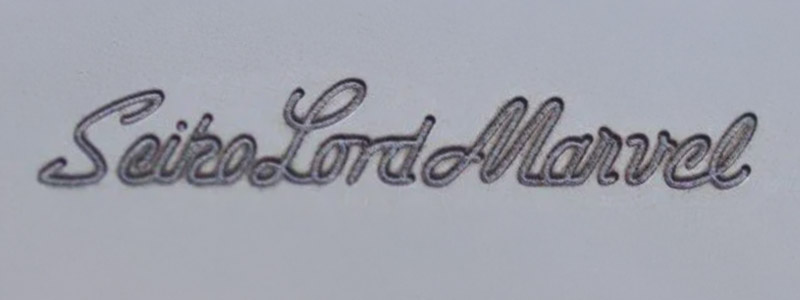
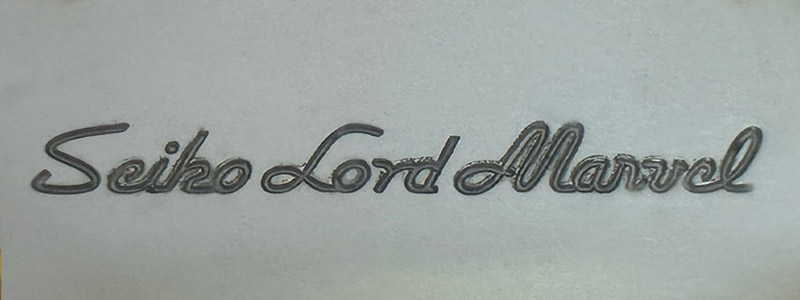
All the Lord Marvel examples I’ve examined with the “curly L” engraving have serial numbers between January and May 1959. One such example is illustrated in a Seiko brochure published toward the end of 1959.
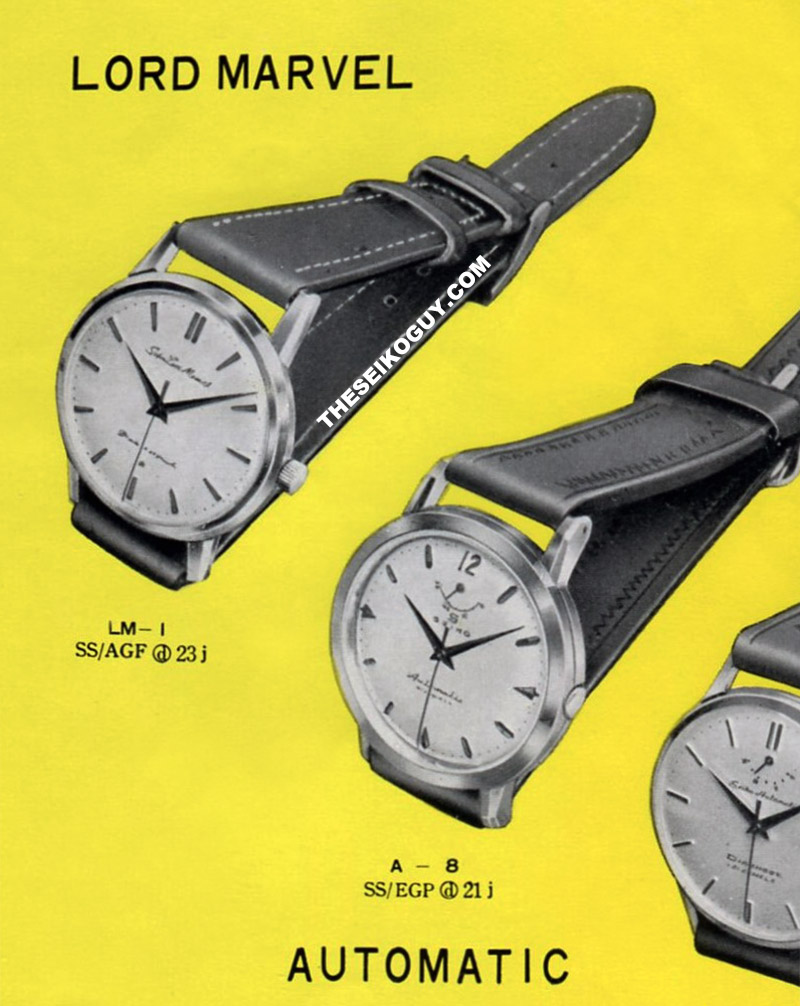
The following are examples of Lord Marvel 14056 and 14057 watches in various configurations, starting from the earliest versions. These watches were sold through auctions over recent years and do not represent all existing configurations.
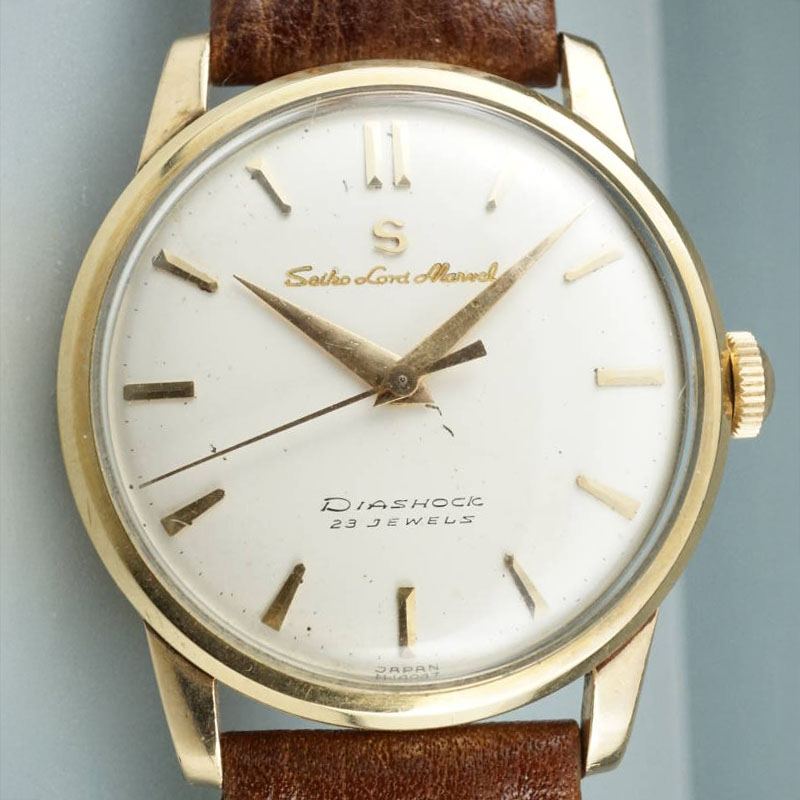
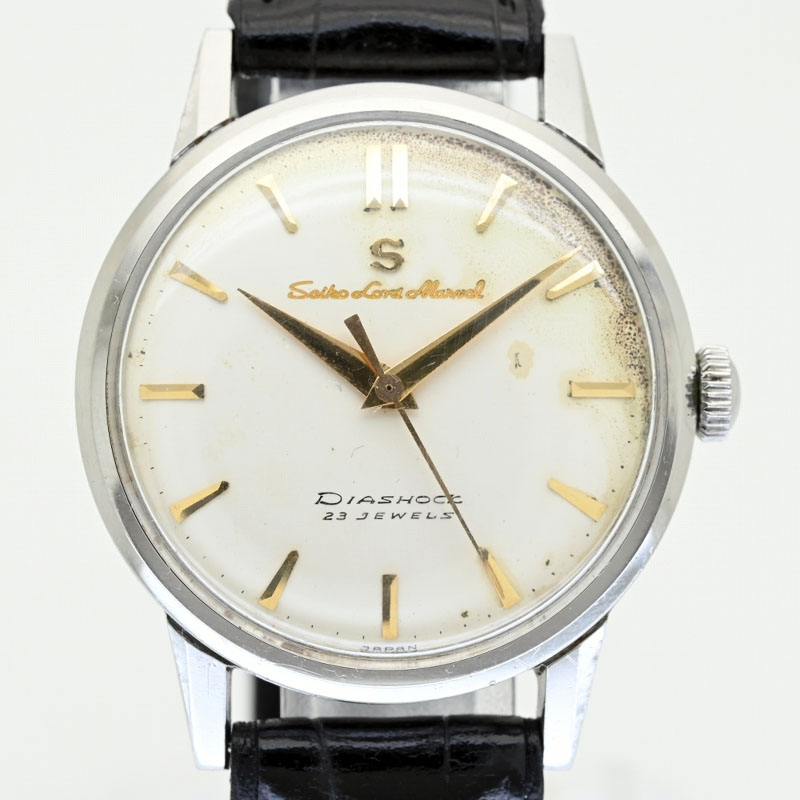
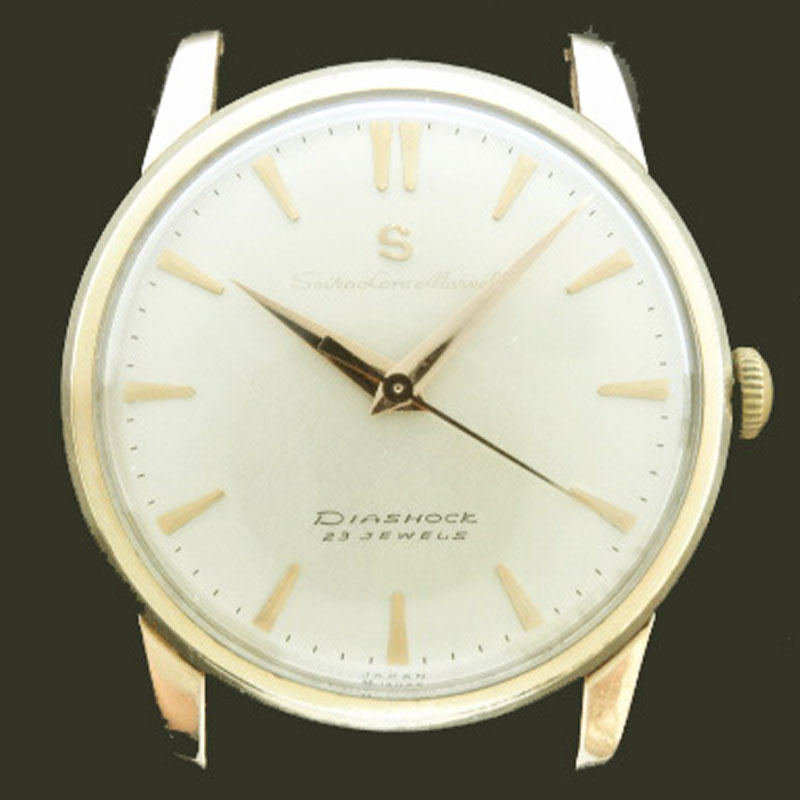
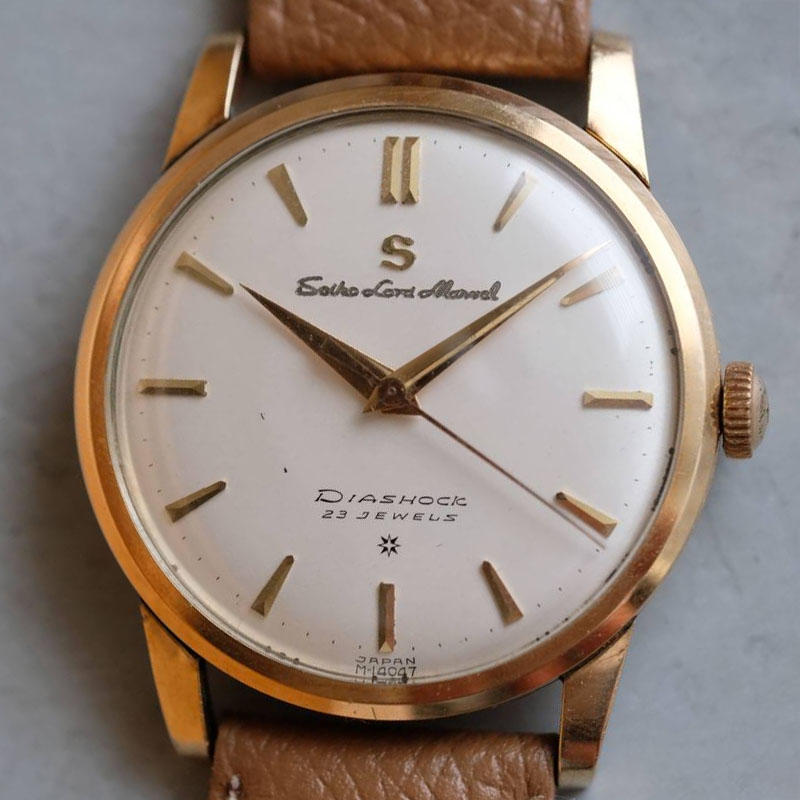
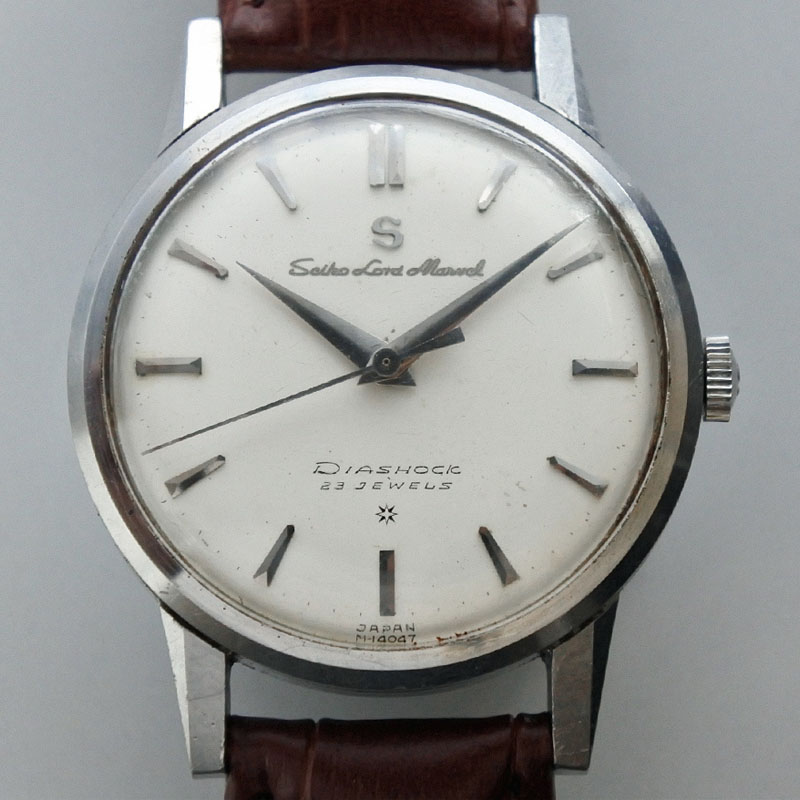
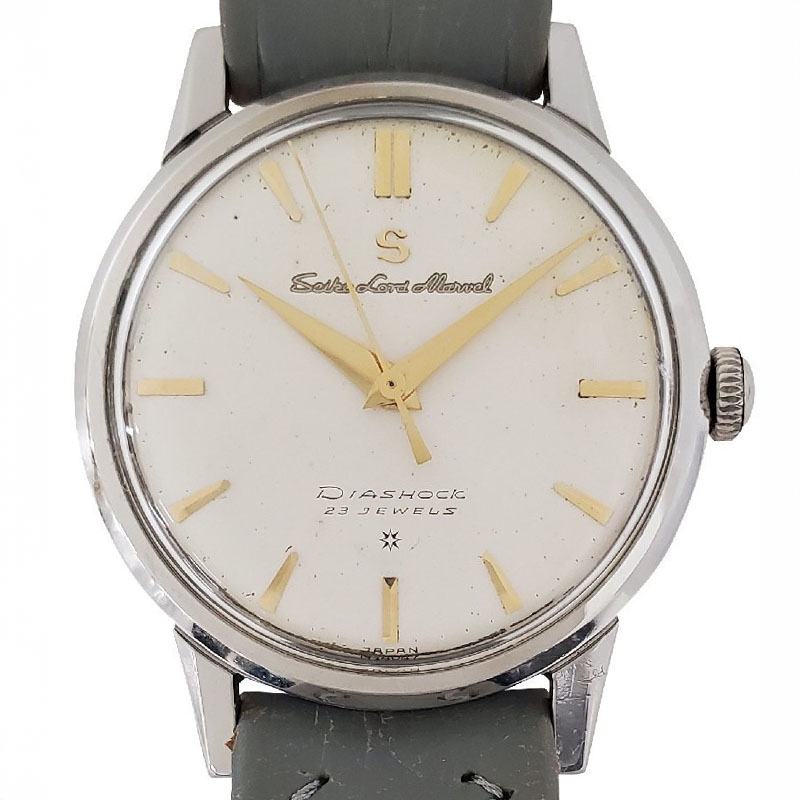

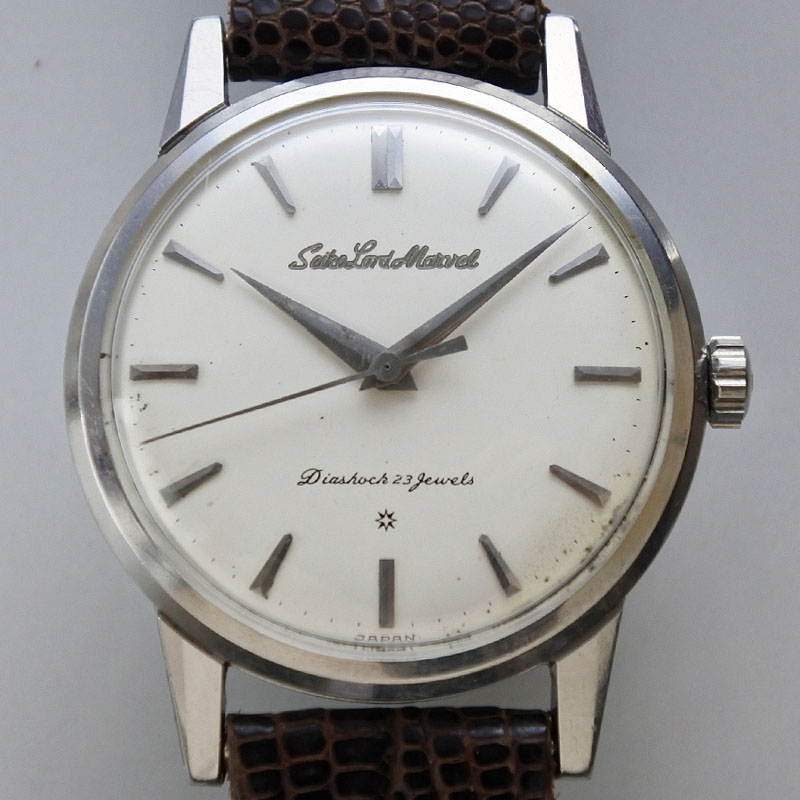
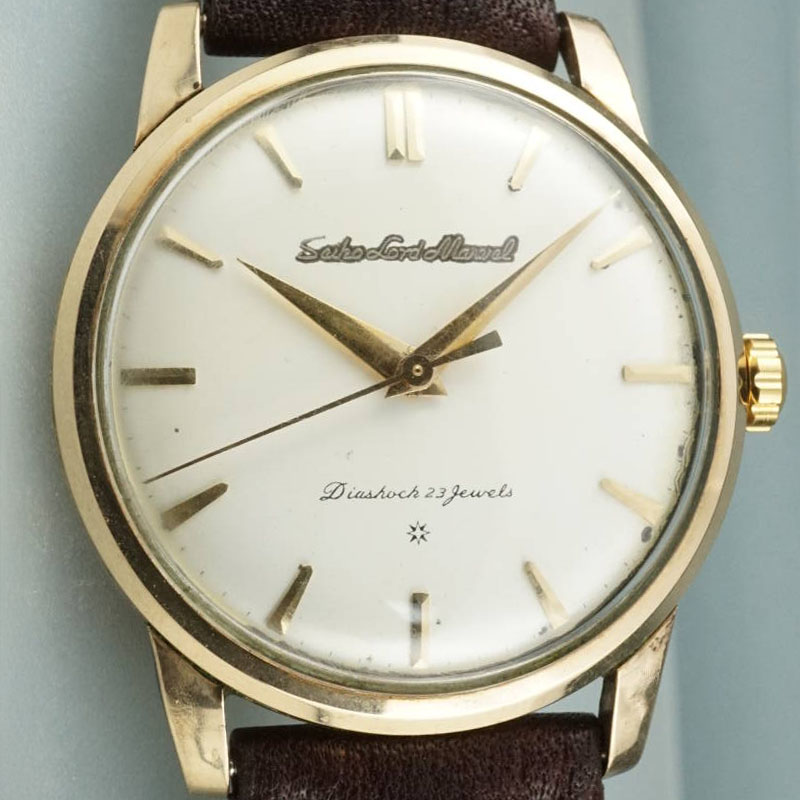
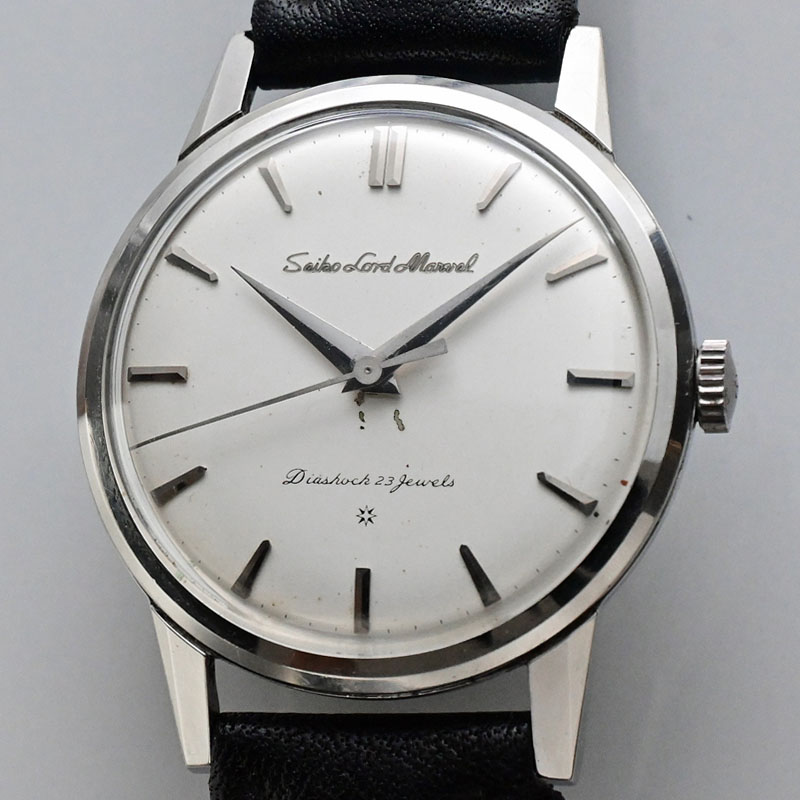
Case Backs of the Early Lord Marvel
The first obvious difference between the case backs of the Lord Marvel 14056 and 14057 is that the Gold Filled version (14057) does not have any exterior engraving, while the stainless-steel 14056 does. The serial numbers are engraved on the inside in both versions.
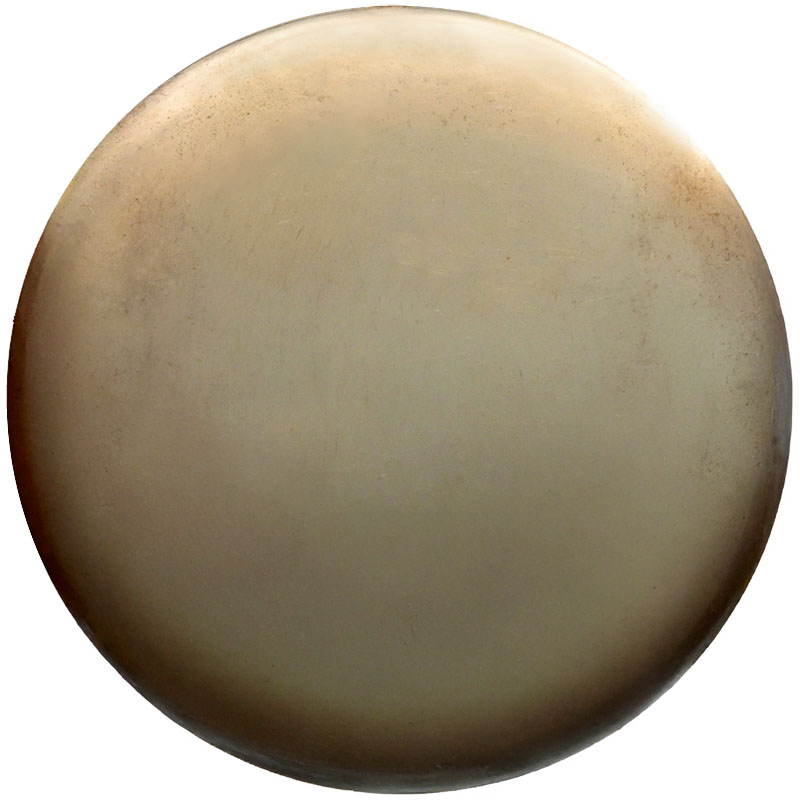
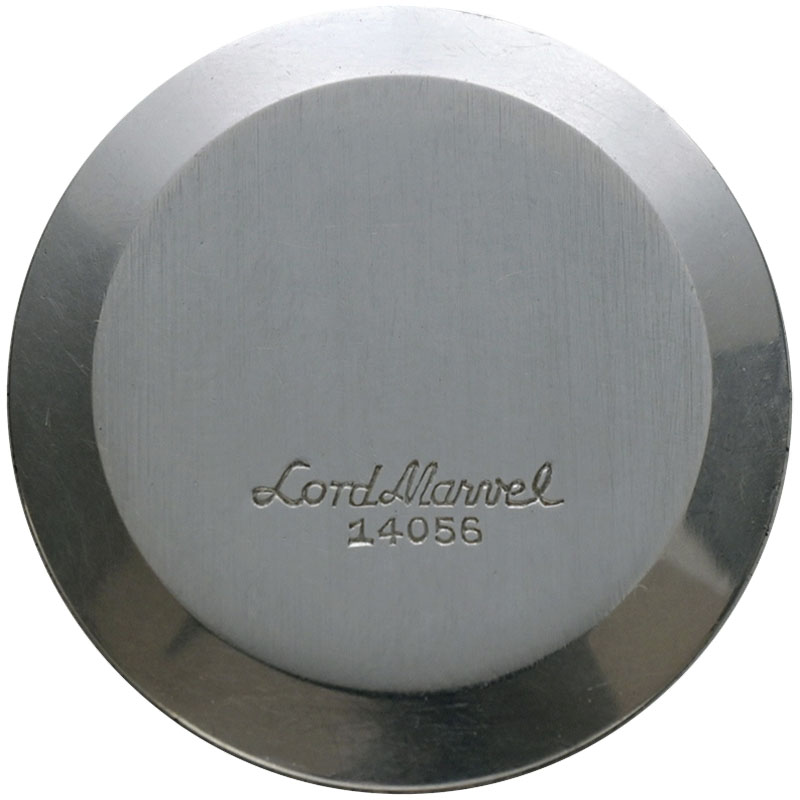
Over the production span of the 14056 stainless-steel Lord Marvel, the case-back engraving changed a few times.
The first version (pictured above) appears on the earliest examples and is associated with dials bearing the applied “S.” The second version is commonly found on subsequent examples without the “S.”
The third version, which includes the words “Specially Inspected,” appears on a very small number of late-production examples and closely resembles the case back of the later Lord Marvel J14038.
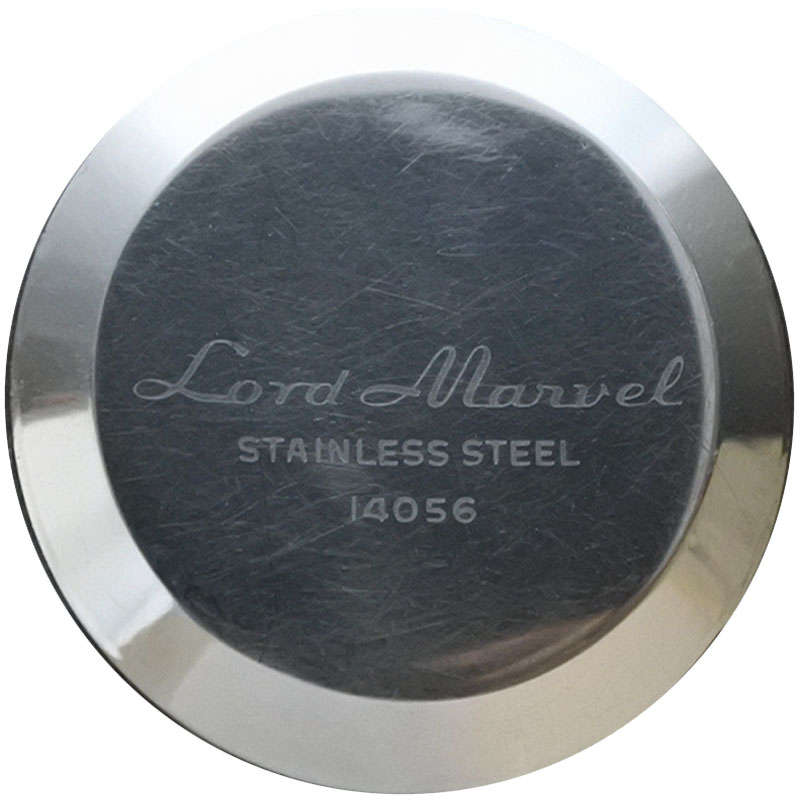
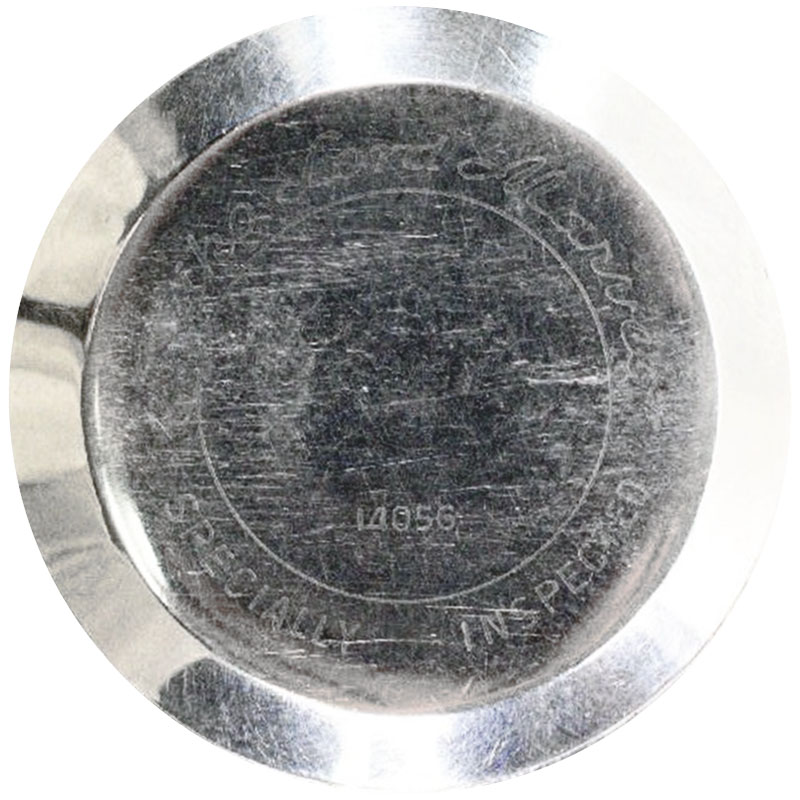
Even though all Lord Marvel 14057 Gold Filled case backs have no external engraving, there is a noticeable difference between early and later versions of these cases.
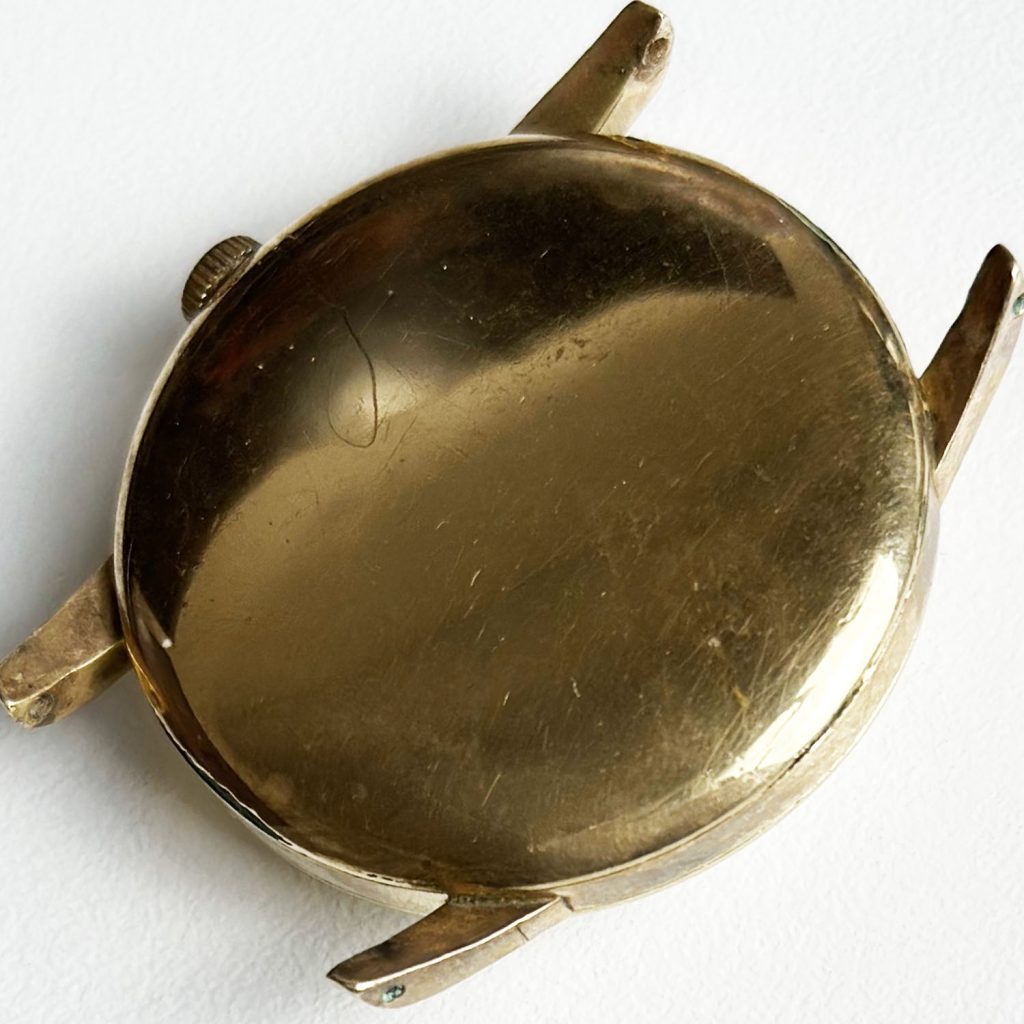
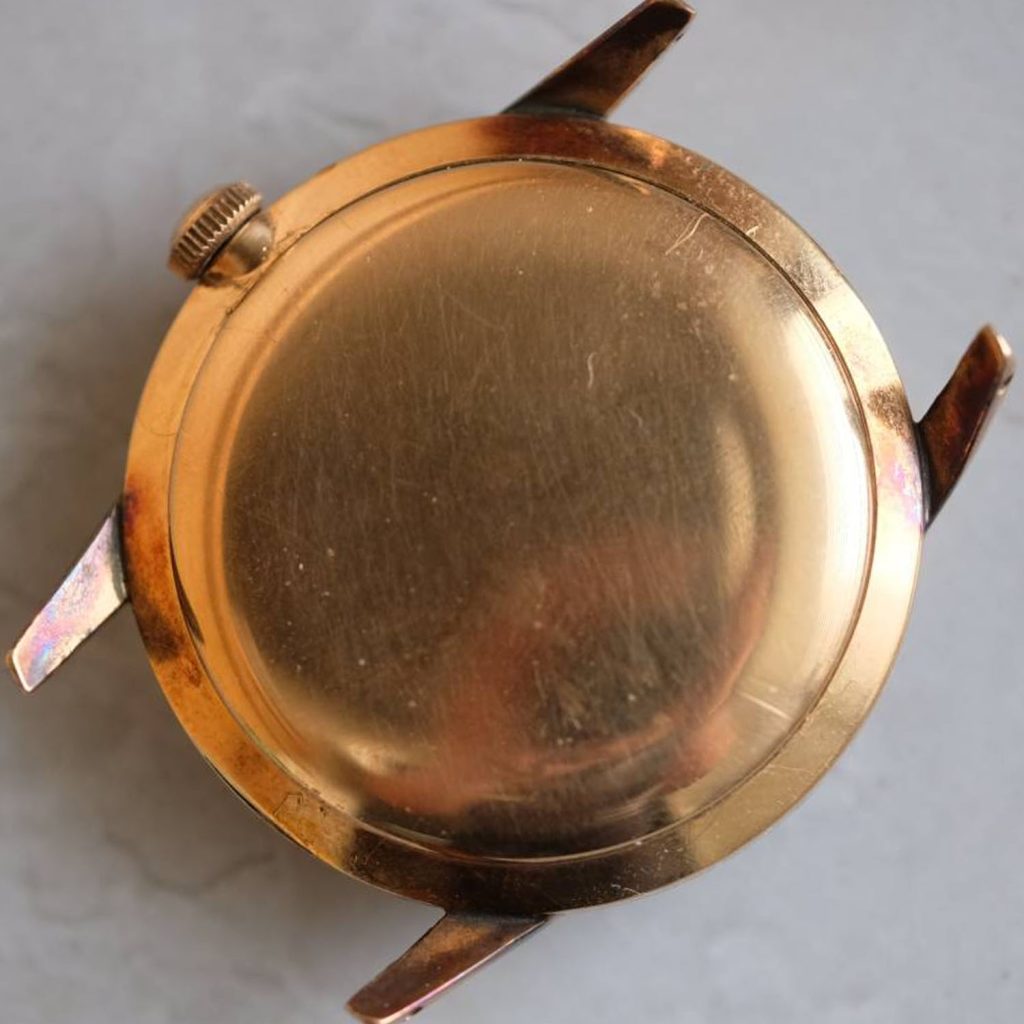
This change in the shape of the Gold Filled Lord Marvel case back, which occurred around late 1958 to early 1959, can also be observed on other Seiko watch models from that period. The general case design and code 14057 remain unchanged.
The Marvel with 21 Jewels
A few months after the Lord Marvel’s introduction, Seiko released a new Marvel with 21 jewels, positioned in Seiko’s lineup as a middle ground between the Marvel and the Lord Marvel.
The announcement of this new, enhanced Seiko Marvel appears in the December 1958 issue of Seiko News.
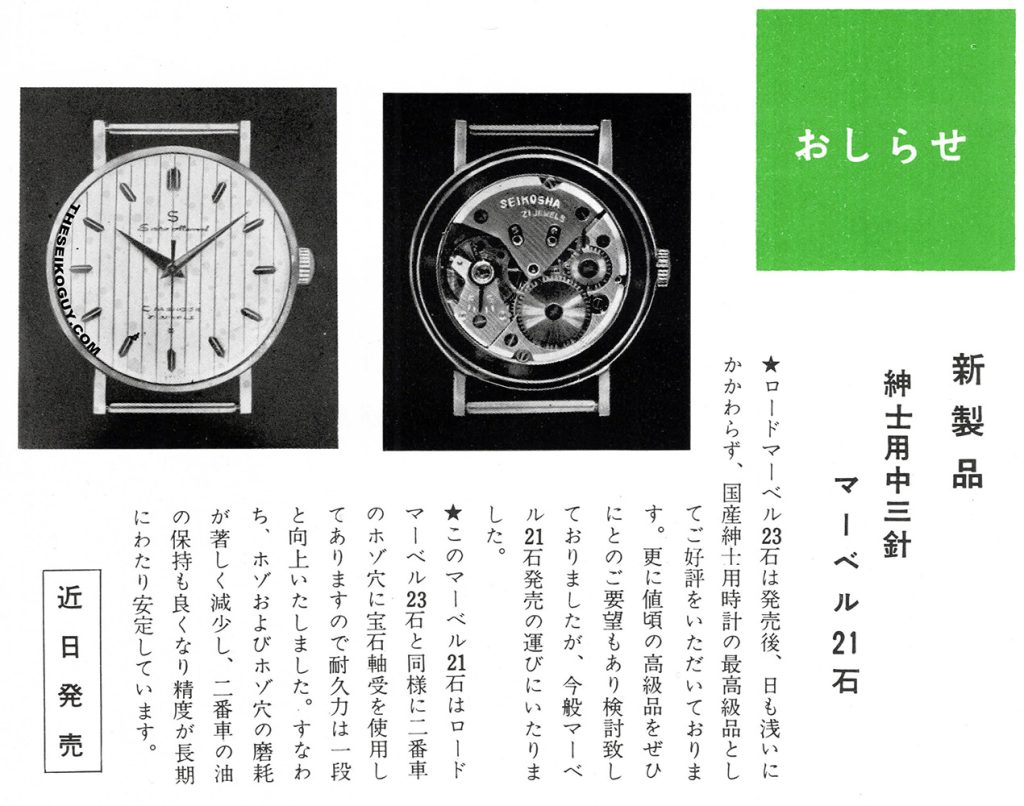
“New Product: Marvel Men’s Watch with Central Three Hands and 21 Jewels.
Despite being released only recently, the 23-jewel Lord Marvel has already received high praise as a top-quality domestic men’s watch. In response to requests for a high-grade product at a more affordable price, we have explored this possibility and are now pleased to announce the new Marvel with 21 jewels.
This 21-jewel Marvel, like the 23-jewel Lord Marvel, uses jeweled bearings in the second-wheel pivot holes, greatly enhancing durability. In other words, wear on the pivots and pivot holes is significantly reduced, oil retention on the second wheel is improved, and accuracy remains stable for a long time.”
In the following photos, you can see a comparison between the 21-jewel Marvel movement and the Lord Marvel movement.
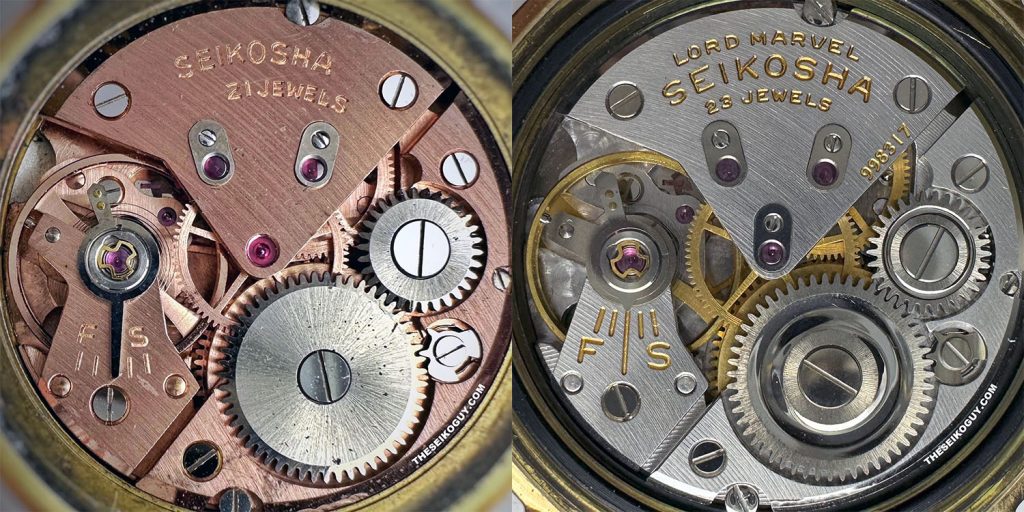
The 21-jewel Marvel can be found with a wide variety of designs and cases, including 18k solid gold. Their quality and the beauty of their dials make them very appealing from a collector’s standpoint.
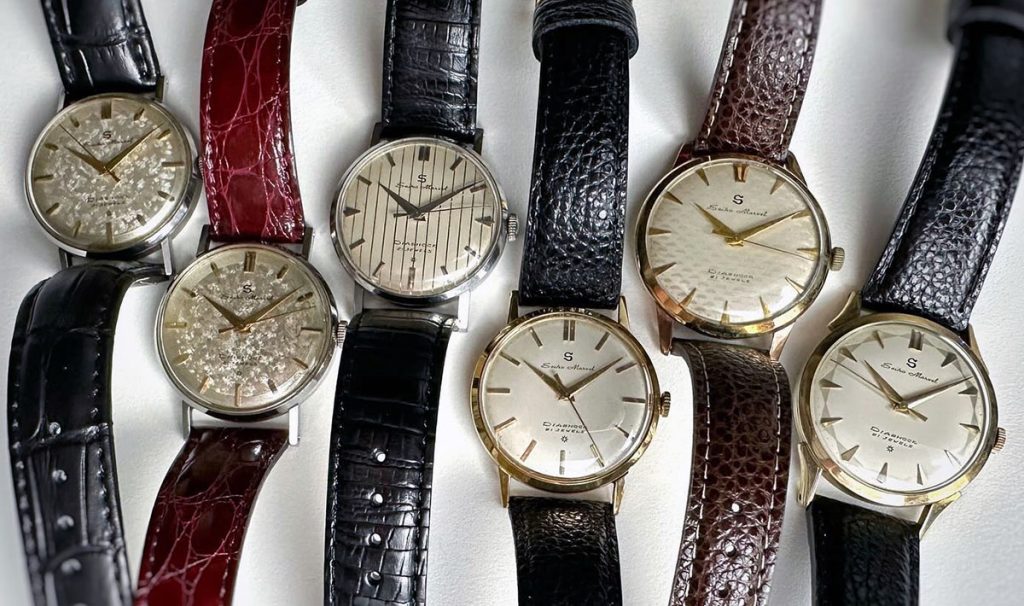
Lord Marvel J14038, J14039, and J14050
A little more than a year after the introduction of the first Lord Marvel 14056 and 14057, updated designs effectively replaced them.
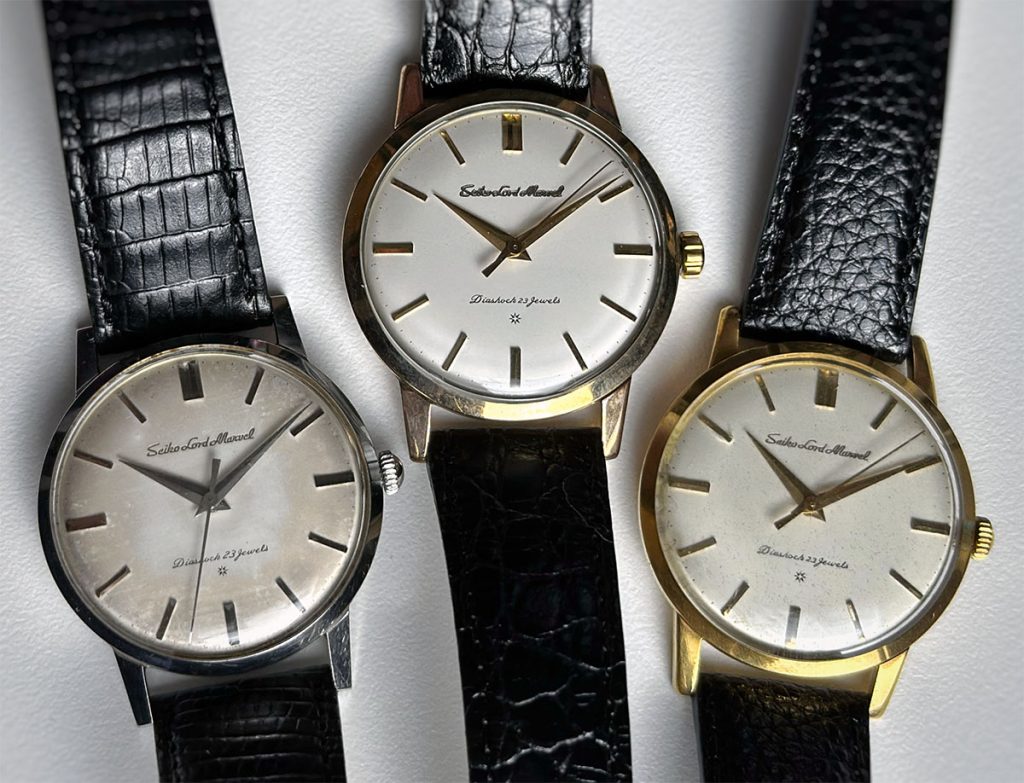
We see three new case codes, all with serials starting in the second half of 1959, right after the earlier models ended production:
- Lord Marvel J14038 with a stainless-steel case
- Lord Marvel J14039 with a 14k Gold Filled case
- Lord Marvel J14050 with an 18k solid gold case
Seiko’s 1960 catalog lists the prices of these three versions.
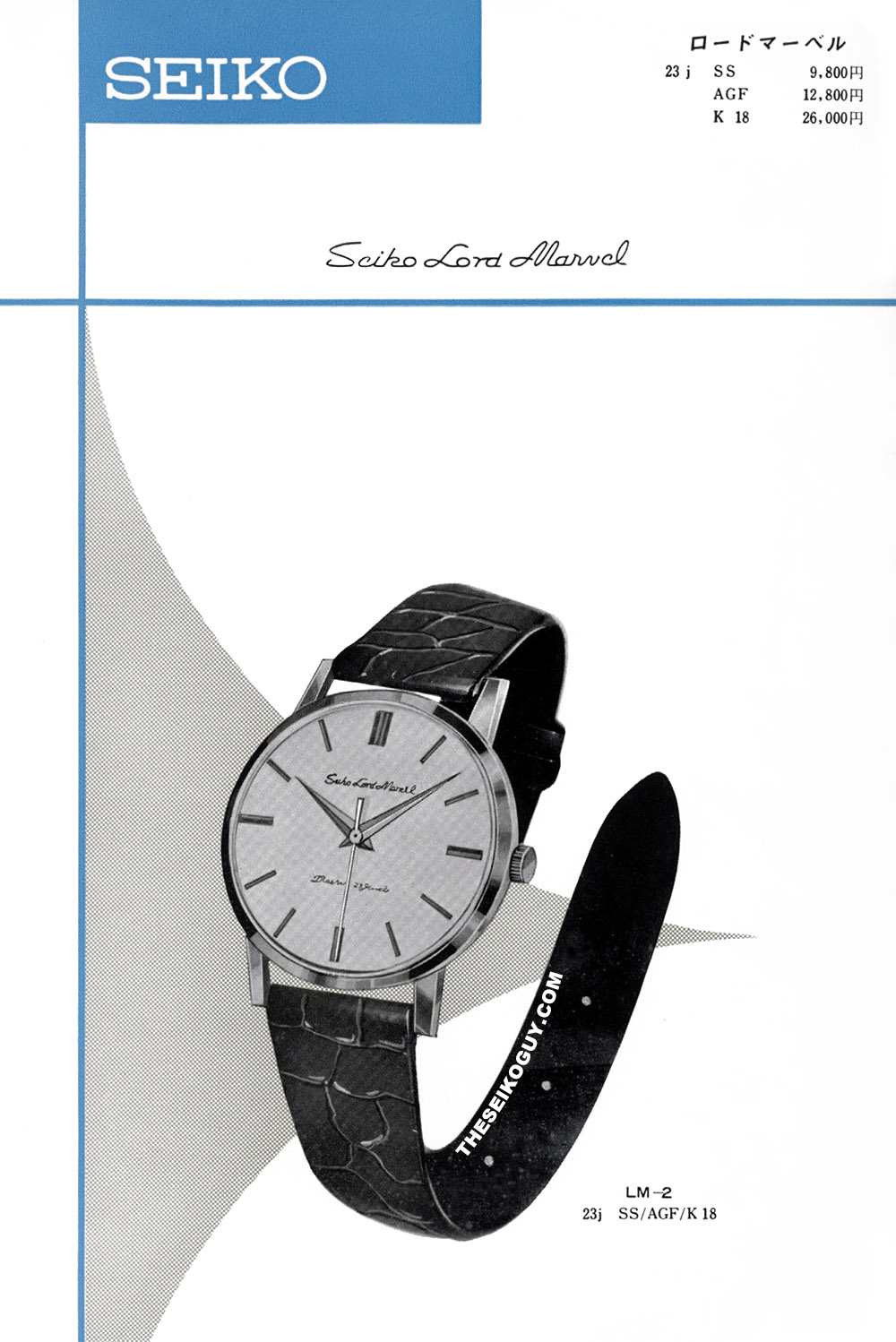
The J14050 is the first Lord Marvel with a solid gold case, priced at 26,000 yen (1,000 yen more expensive than the first Grand Seiko with a Gold Filled case, introduced the following year).
The prices of the Lord Marvels in steel and gold filled remained unchanged from the previous versions (12,800 yen for gold filled and 9,800 yen for steel).
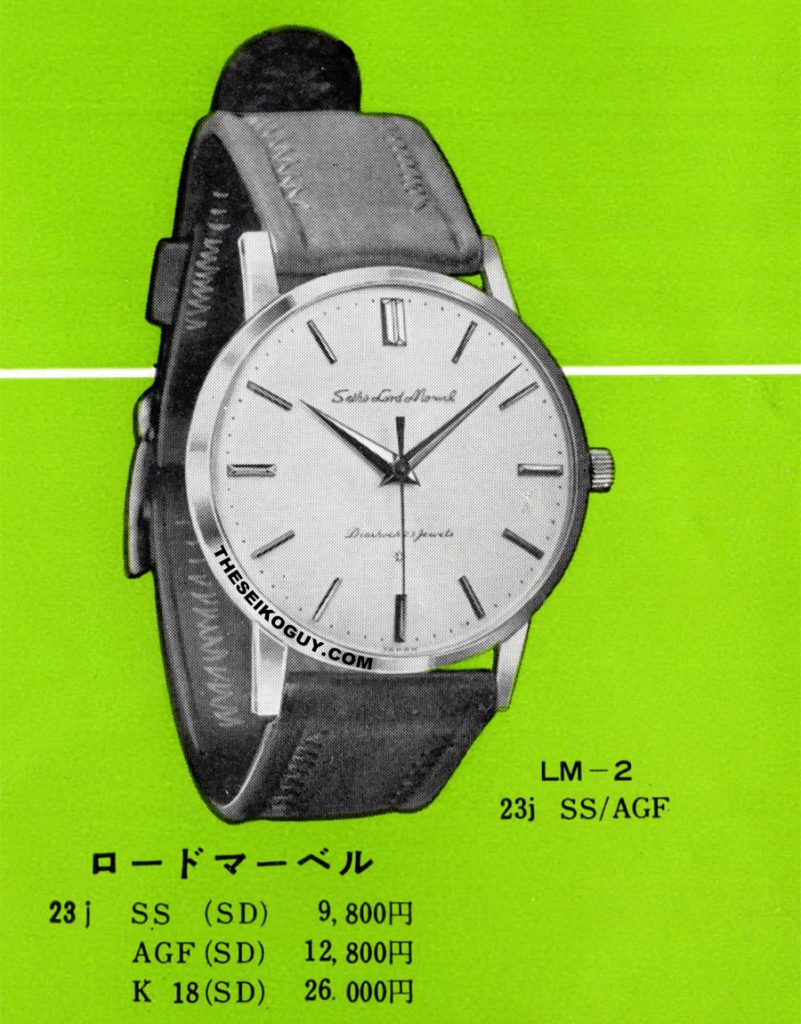
As with the earlier Lord Marvel models, various configurations exist, including steel cases fitted with gold-tone markers.
All these models have engraved “Seiko Lord Marvel” dials with the SD (Special Dial) symbol. You may encounter a few exceptions with a printed logo and the AD symbol, but in my opinion these are replacement dials produced by Seiko in the 1960s as spare parts (I will discuss this topic later in the guide).
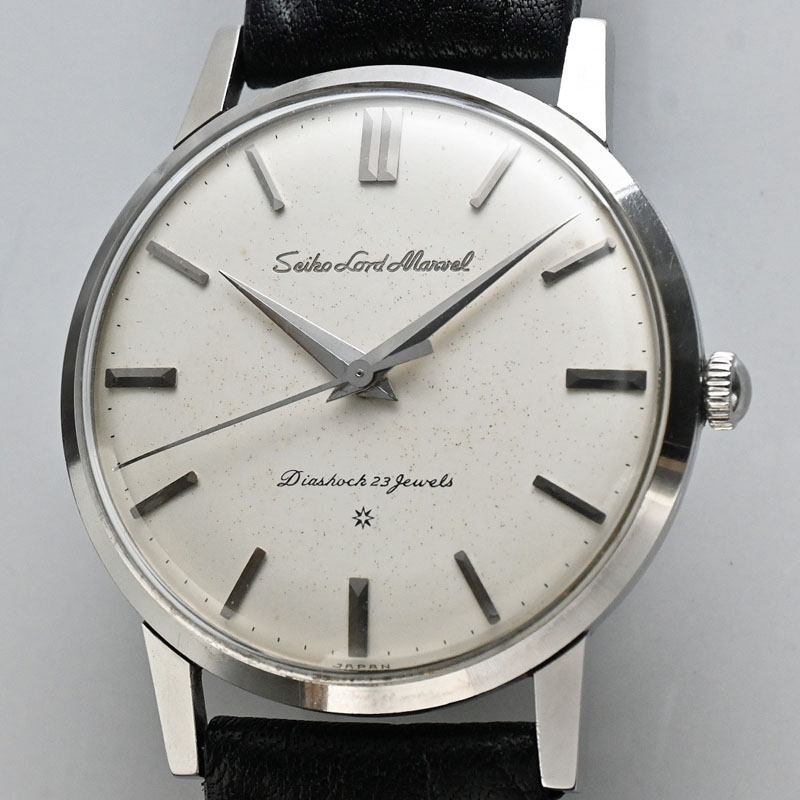
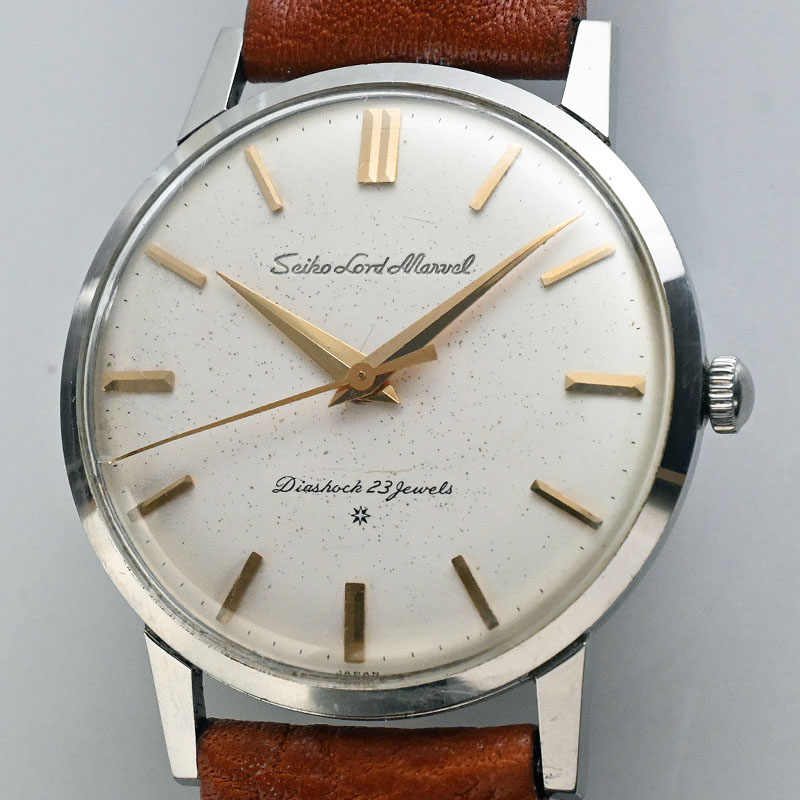
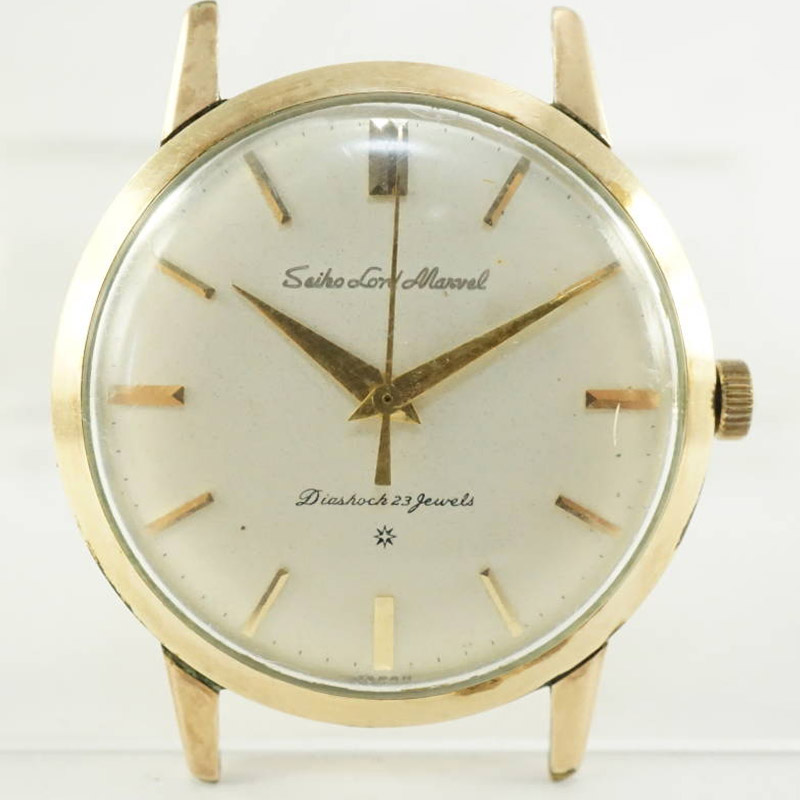
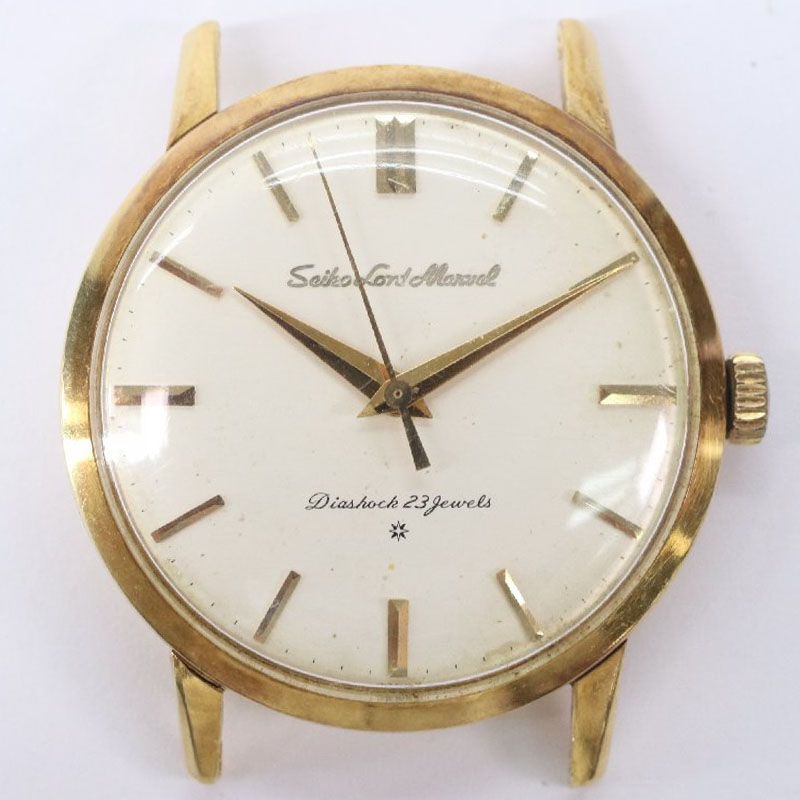

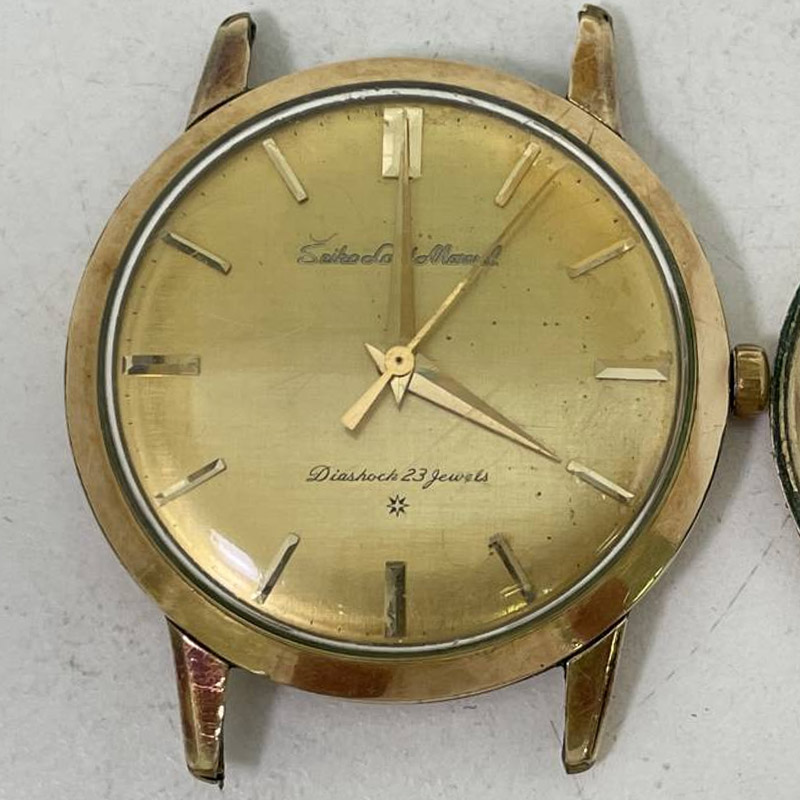
Lord Marvel J14068
In addition to the models listed above, there is the Lord Marvel J14068 with a Gold Filled case. This model is very similar to the J14039 but differs primarily in the shape of its lugs.
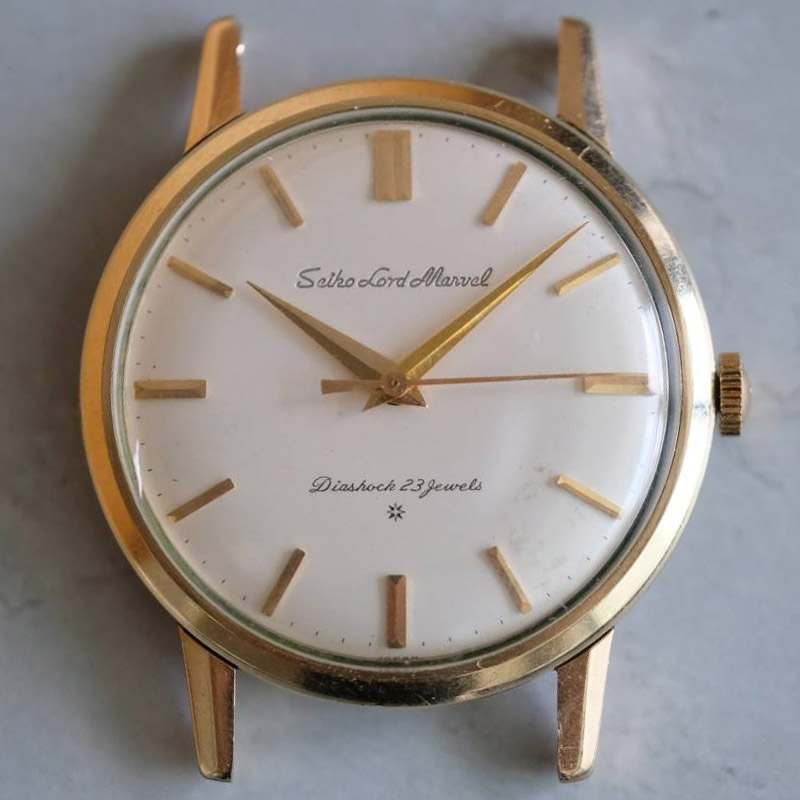
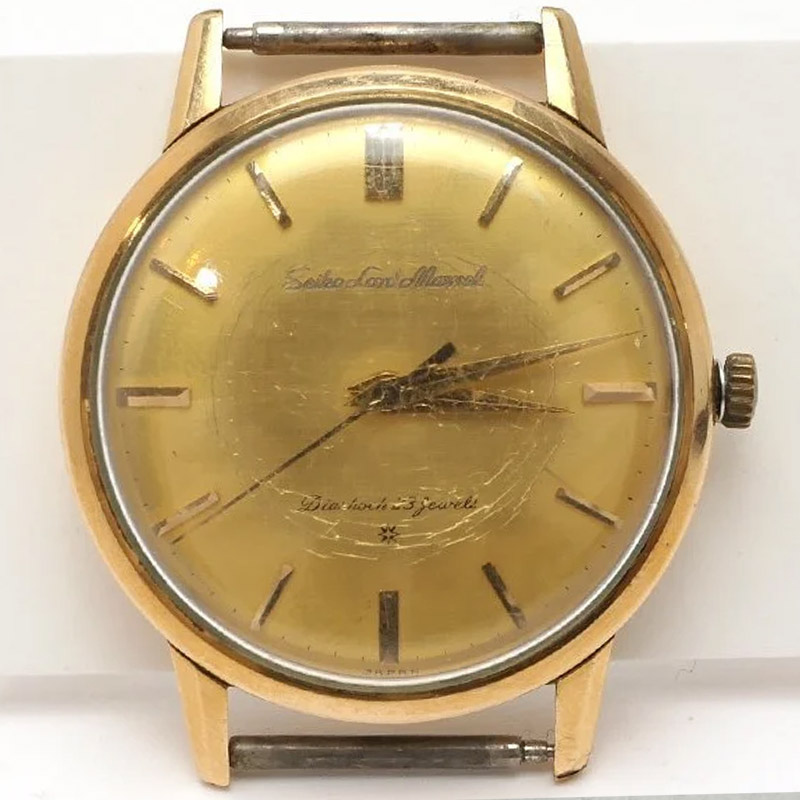
Printed Logo and AD Dial on Early Models
All the Lord Marvel models discussed so far (1405x and J140xx) originally come with engraved “Seiko Lord Marvel” dials. However, during my research, I found some examples with AD-type dials and a printed logo, very similar to those of models produced in later years (1502x).

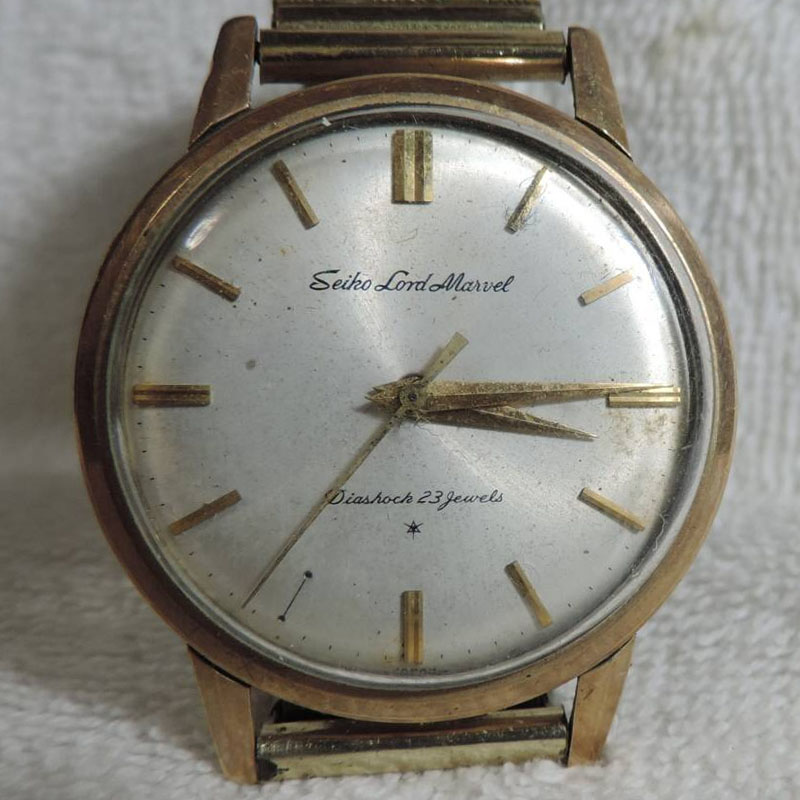
At first, I thought they might be transitional watches from the end of the J140xx production run, but the serial numbers quickly dismissed this hypothesis.
In reality, as the following example shows, these are almost certainly replacement dials made by Seiko in the 1960s as spare parts.
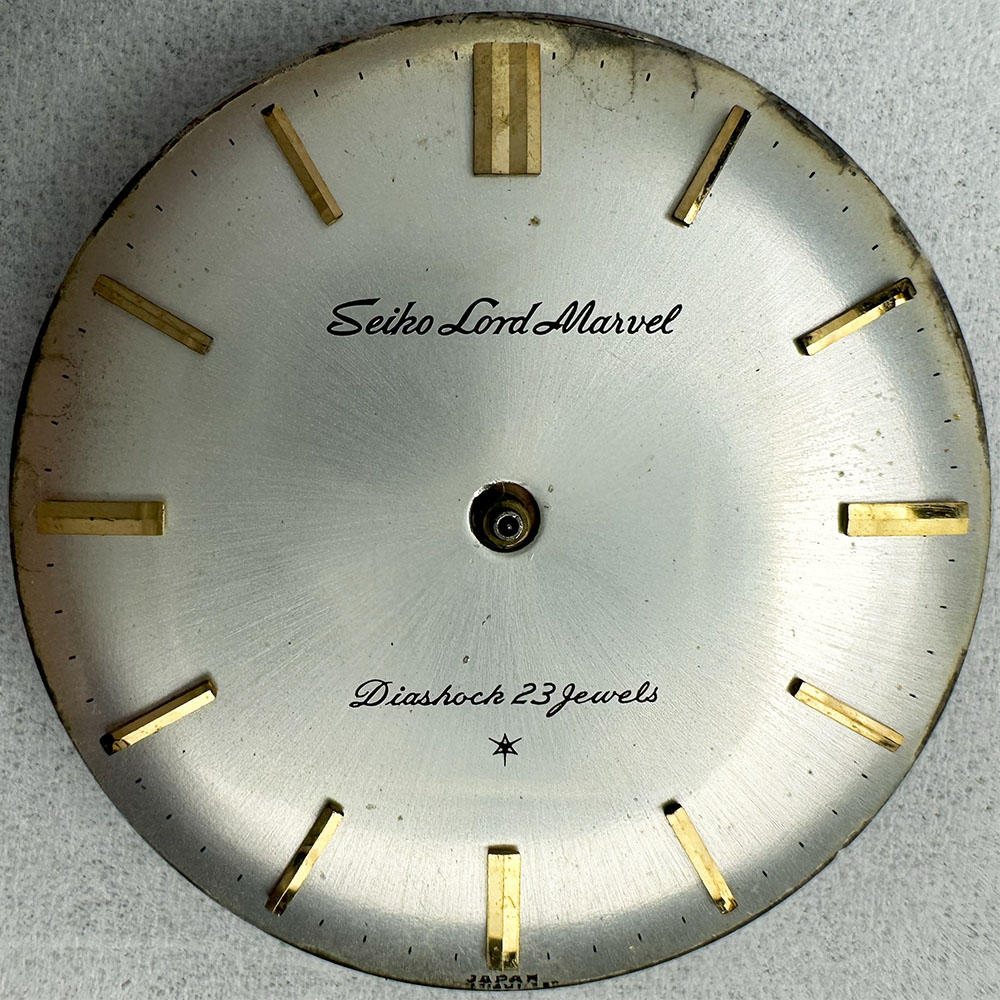
This is the dial of a Lord Marvel J14038 with a case code dated October 1959, so one of the first production batches. A dial of this type, with the AD logo, could not have been produced in 1959.
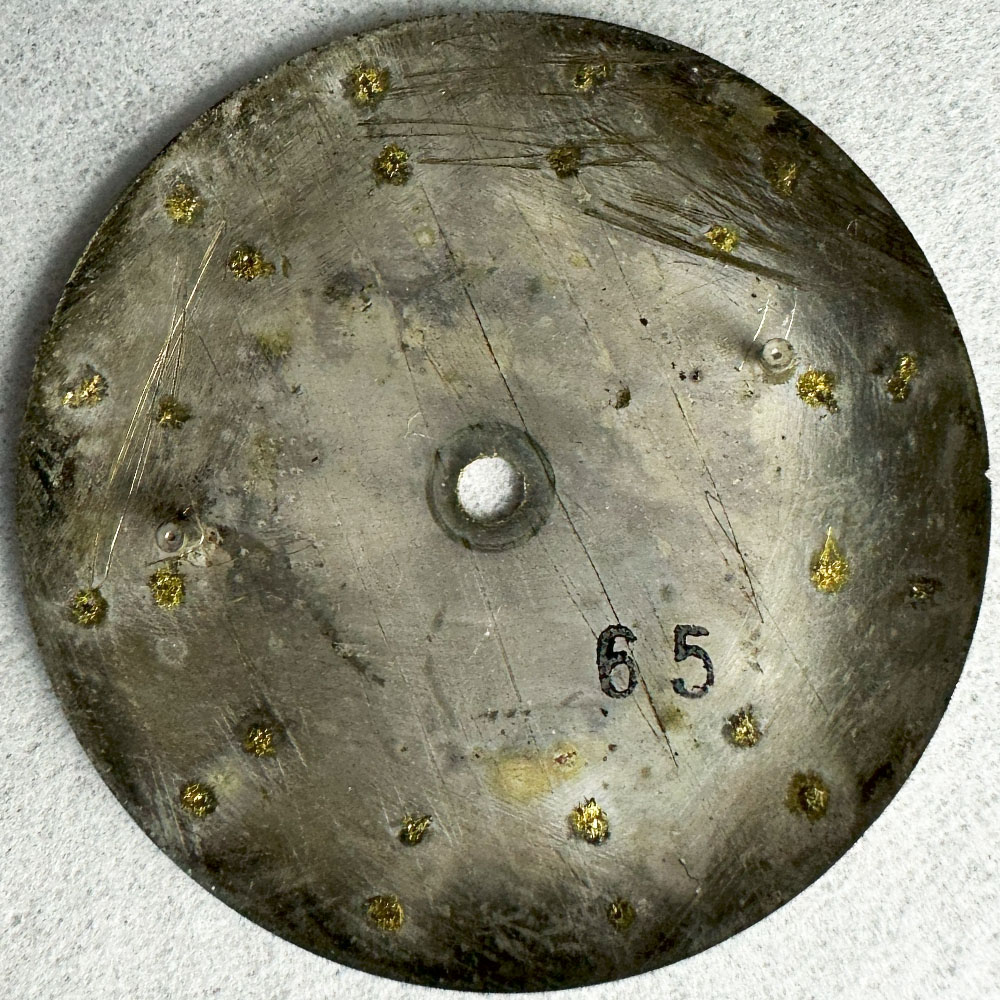
As I suspected, the two digits printed under the dial indicate that it was produced several years later, in May 1966.
The simplest and most logical explanation, in my view, is that these are dials made as spare parts for older models sent in for servicing.
It’s impossible that they came directly from later-model Lord Marvels, as later series had larger dials that do not fit the J140xx cases.
Lord Marvel 15023 and 15027
The final models produced in the first generation of Lord Marvel are the 15023 and 15027. While they look very similar, the main difference once again lies in the type of lugs.
Based on the serials of the examples I’ve examined, the earliest date to October 1961.
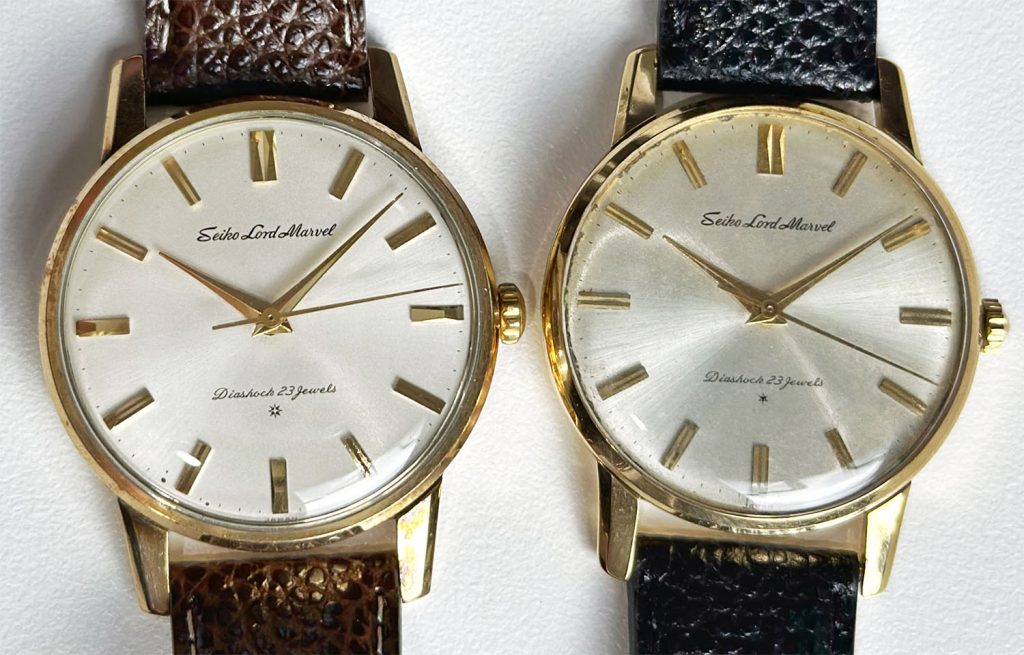
Unlike all earlier Lord Marvels, which each case code associated with a single material, both the 15023 and 15027 can be found in steel, gold filled, and 18k solid gold.
With these models, Seiko introduced dials with a printed logo, and no 15023 or 15027 example is found with an engraved logo.
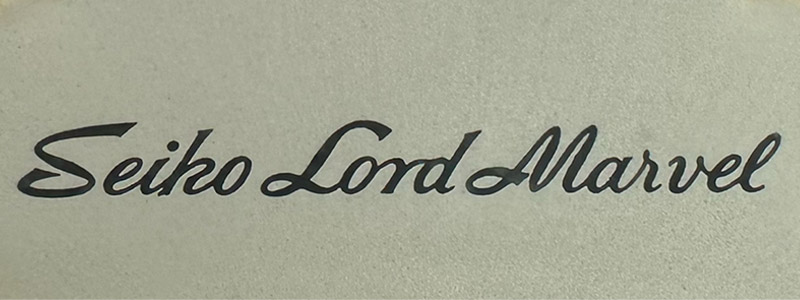
About halfway through these models’ production runs, a transition occurred from SD (Special Dial), with solid-gold markers, to AD (Applied Dial), with SGP (Strong Gold Plating) or rhodium-plated markers.
Among the 15023 and 15027 Lord Marvel examples I analyzed, all with serials up to May 1963 are SD, while from June 1963 onward they are all AD.
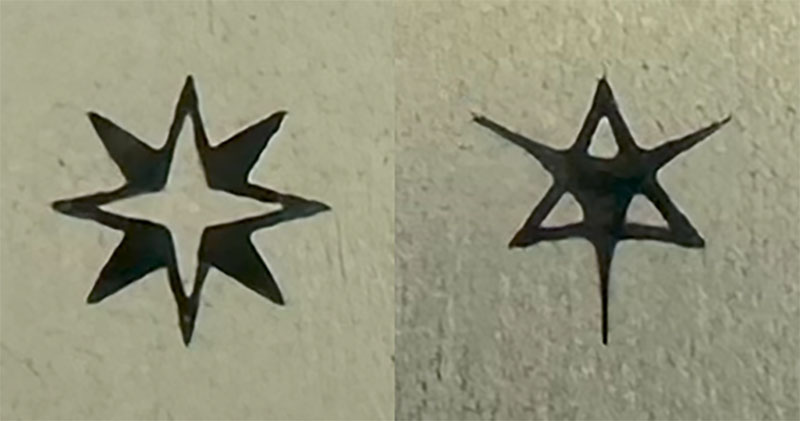
The following brochure, published in late 1963, shows several of Seiko’s top models of the time, including a Lord Marvel 15027 with an AD dial.
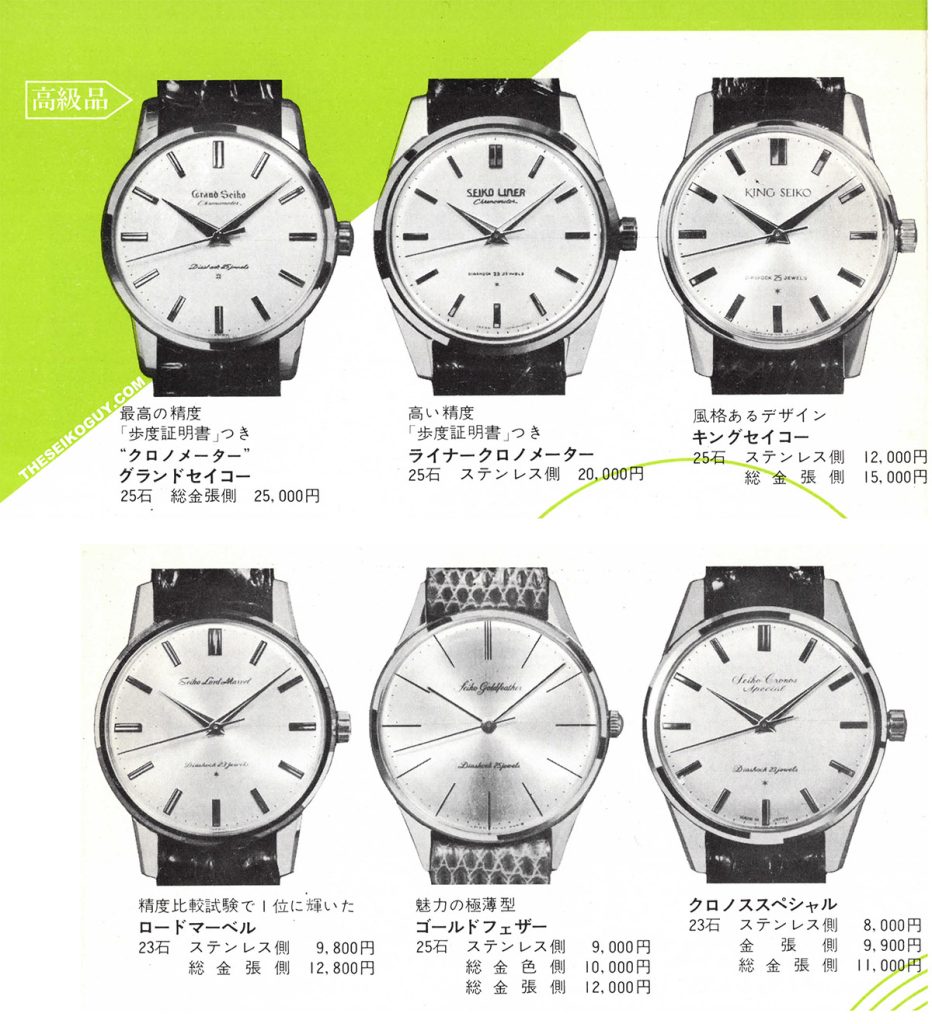
Below are several examples of Lord Marvel 15023 and 15027 in various configurations, also from auction listings over the years.
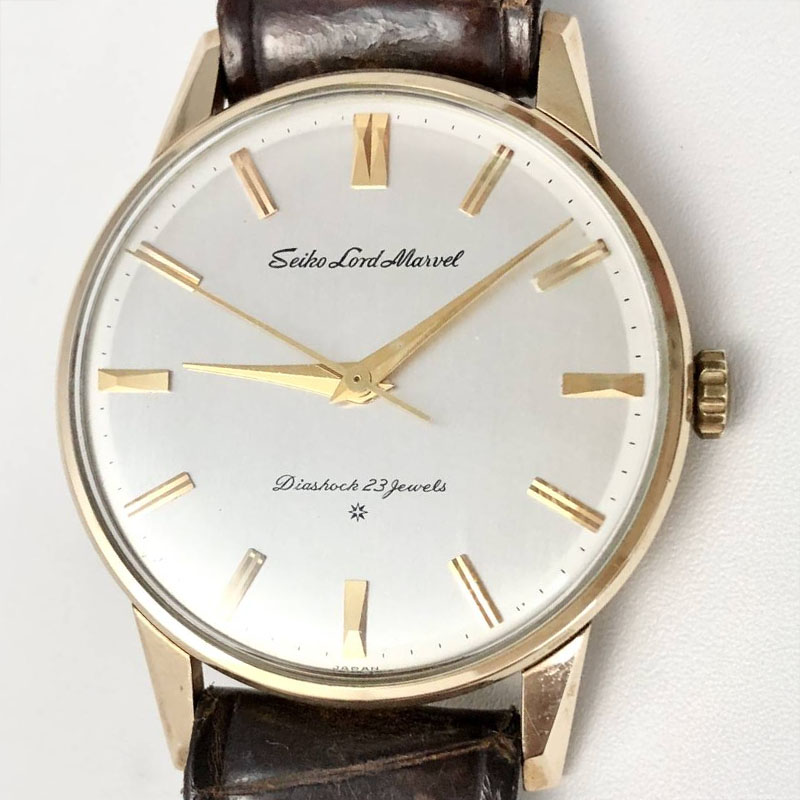
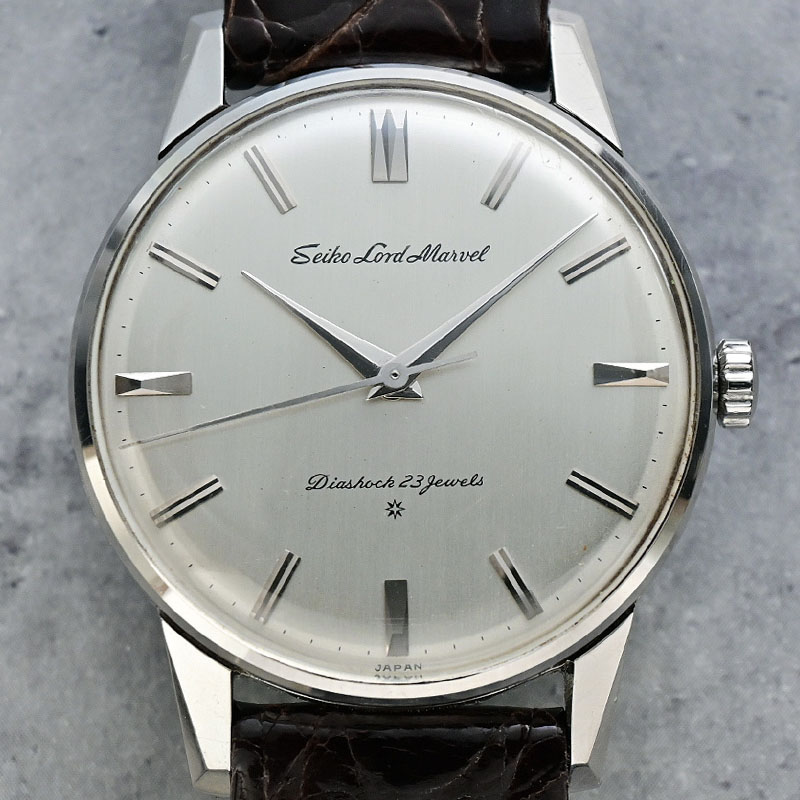
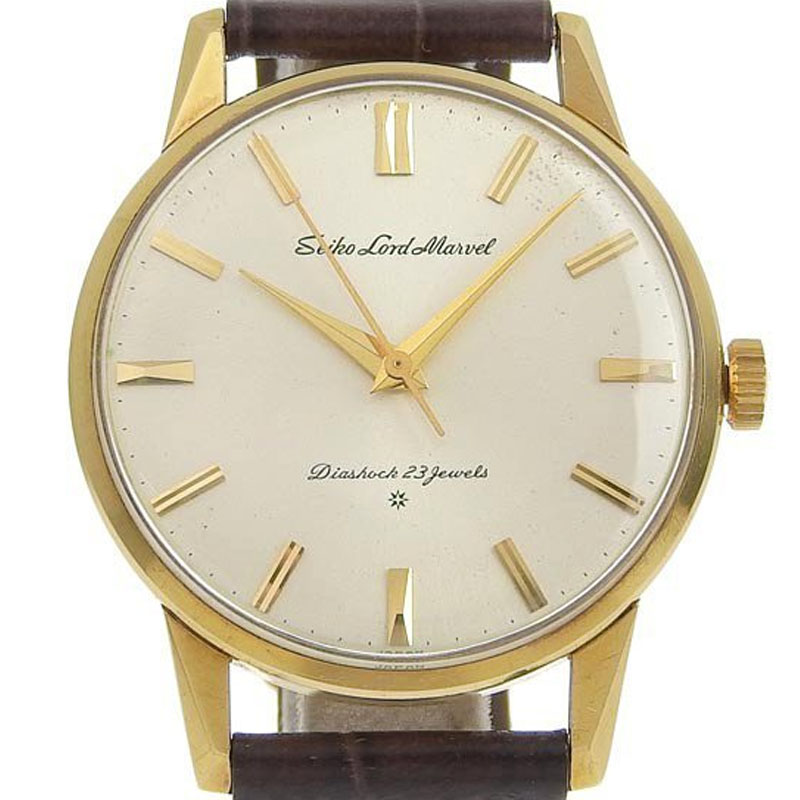
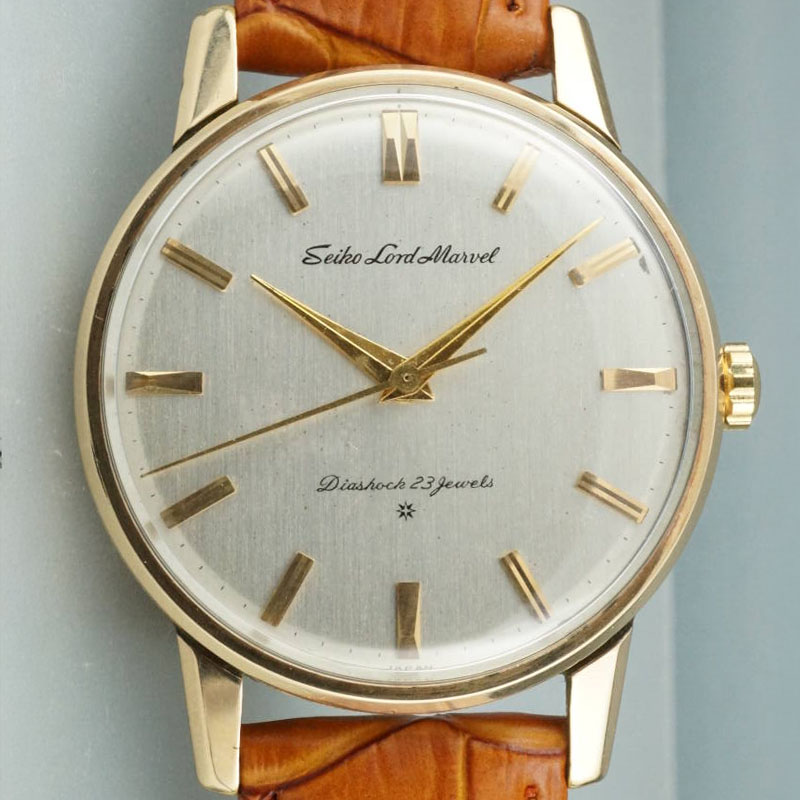
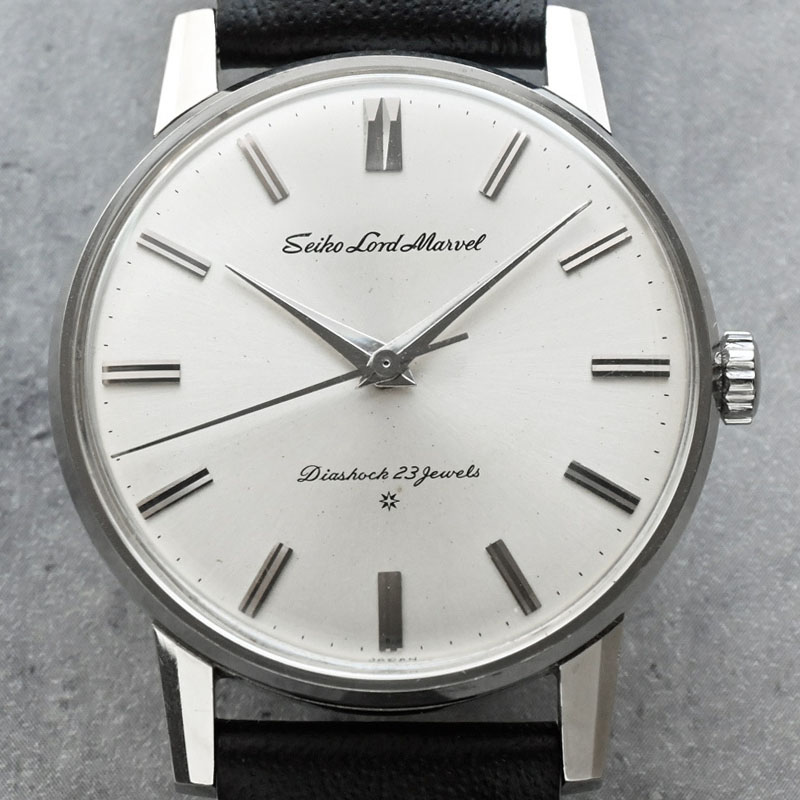
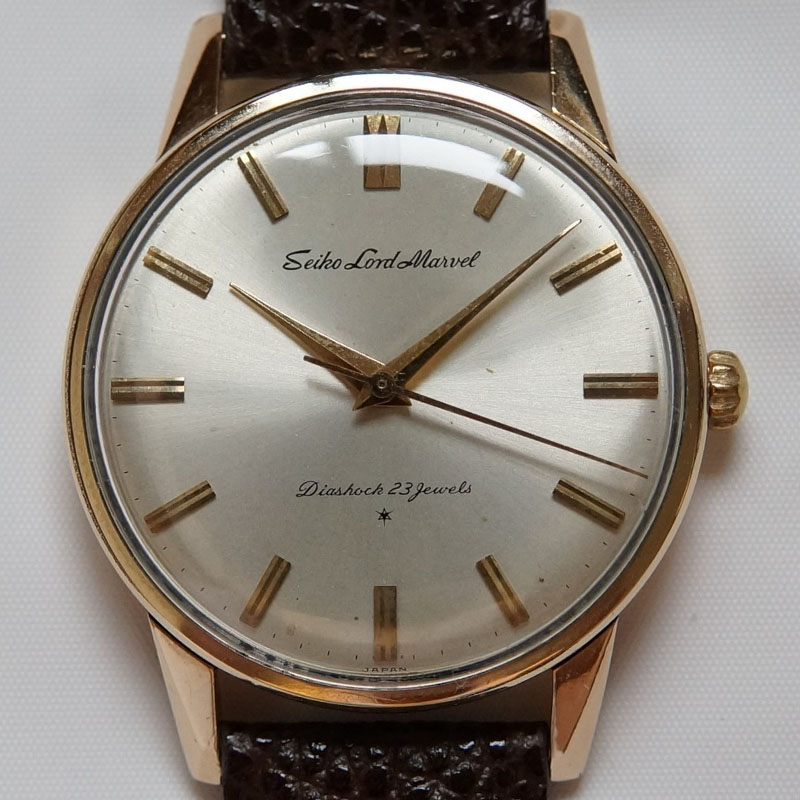
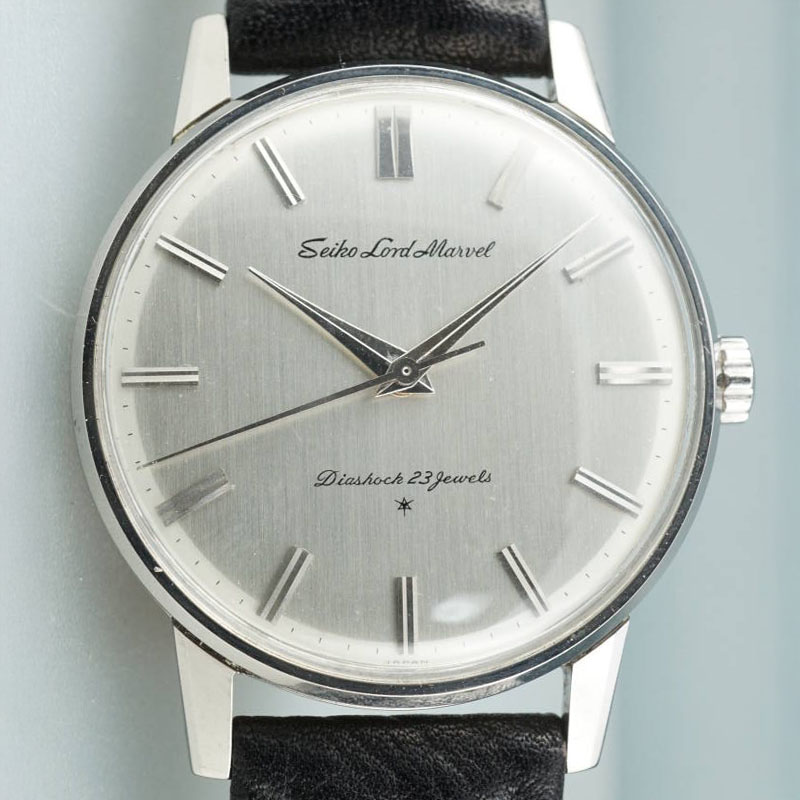
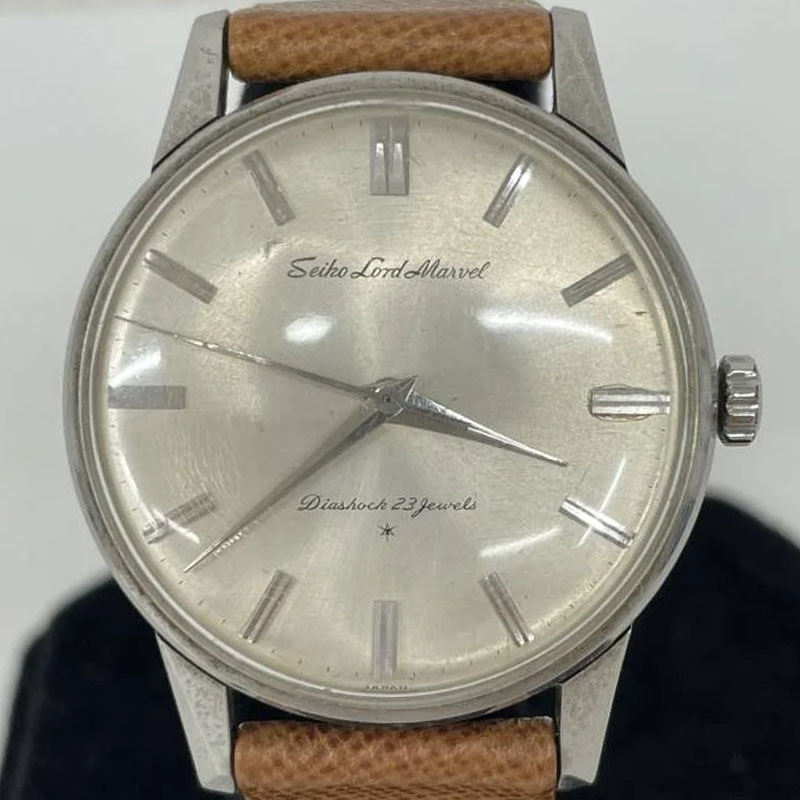
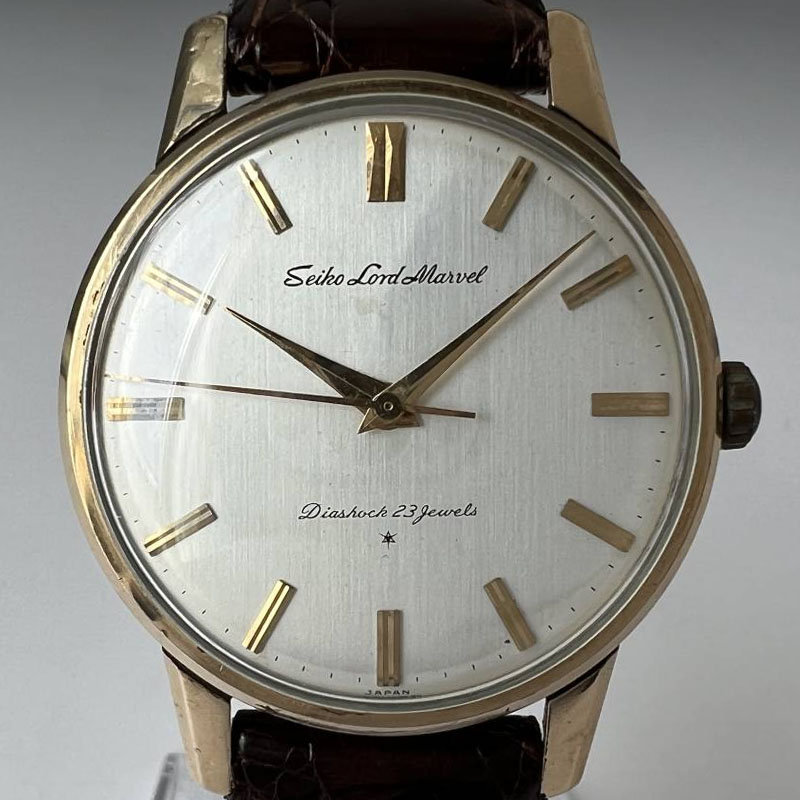
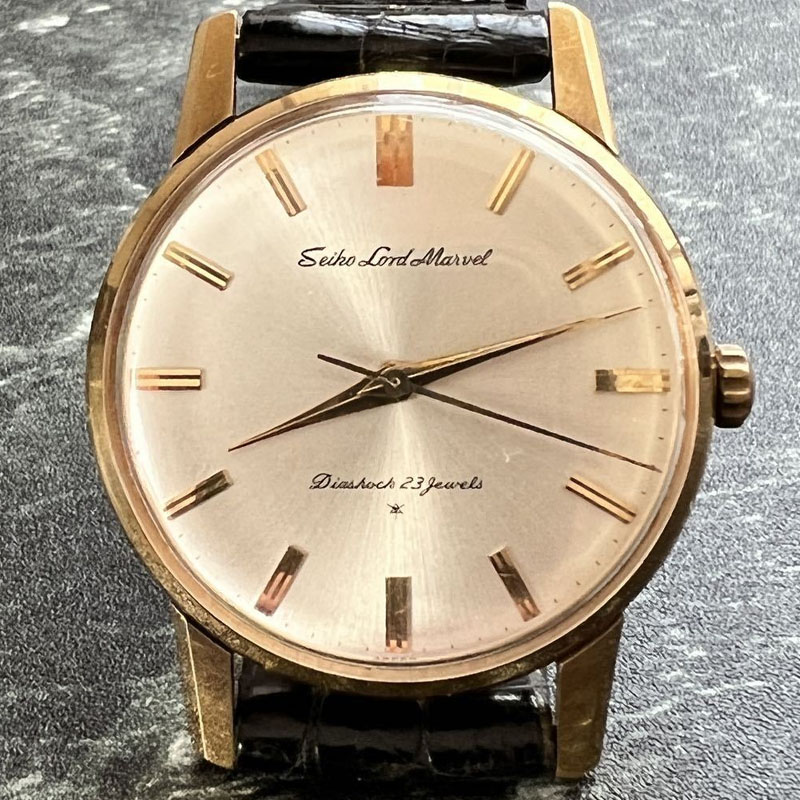
The Lord Marvel Movement
One noteworthy characteristic of the Lord Marvel’s movement, which was new in 1958, is the presence of a “serial number.” Initially, this was a four-digit number that wasn’t unique but represented the year and production batch.
Movements marked 5701 belong to the first production batch (batch No. 1 of the year 1957).
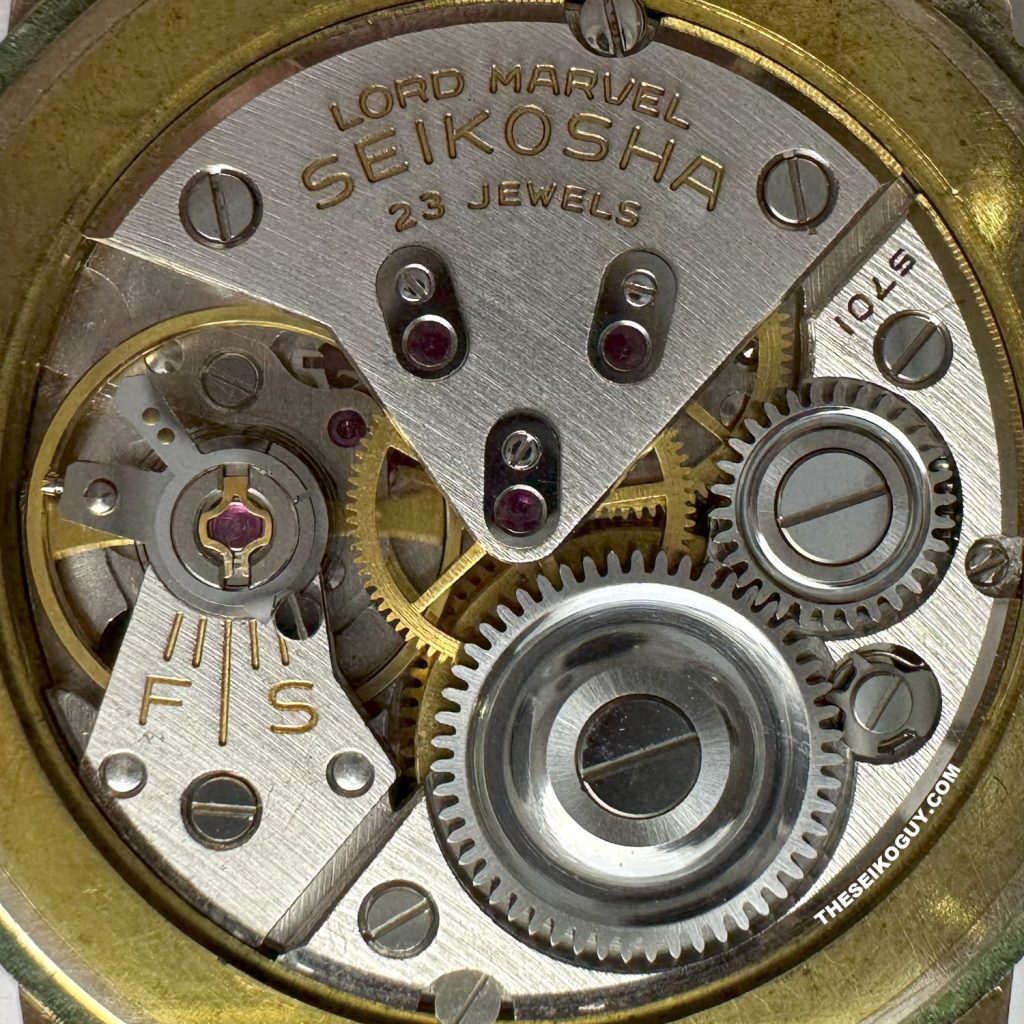
All Marvel 14056 and 14057 watches have movements with four-digit serials.
Starting with the Lord Marvel J140xx, you begin to see movements with six-digit serials, which are unique identifiers and no longer refer exclusively to the production batch.
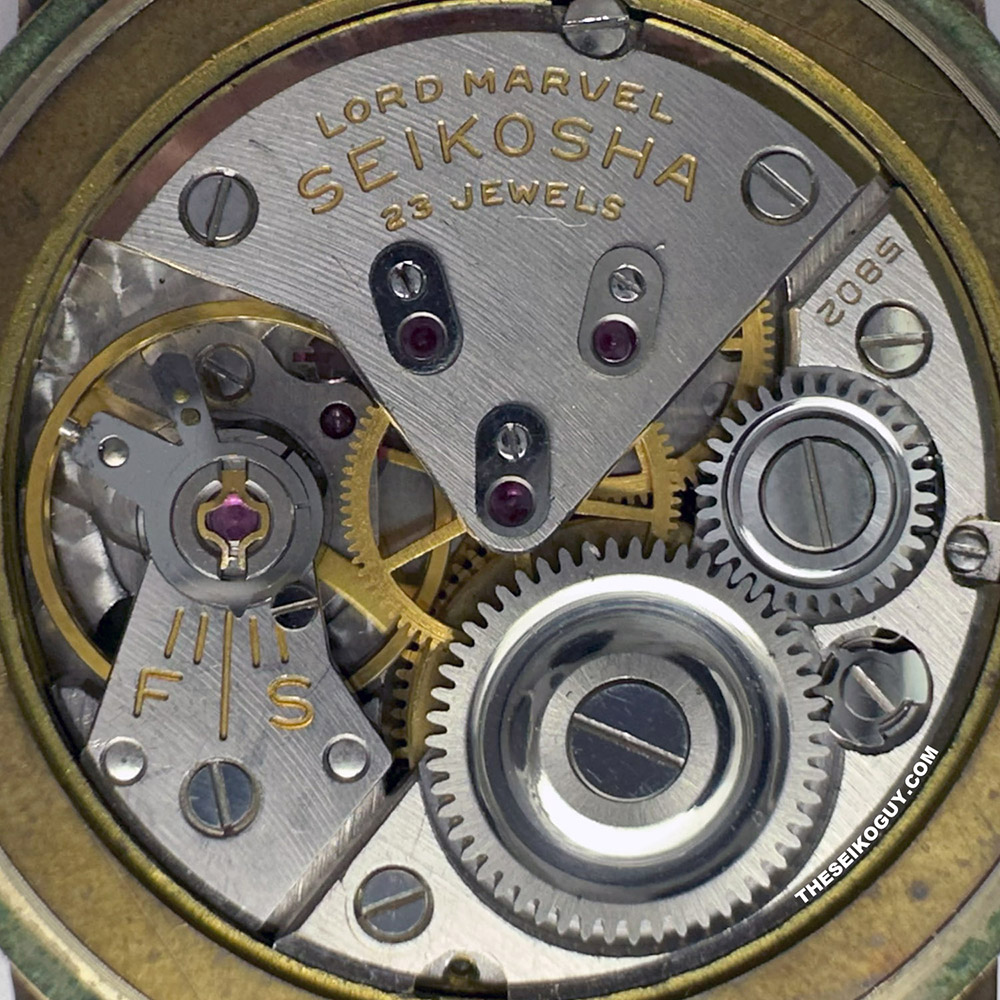

You can also see that the location of the serial number on the movement is different.
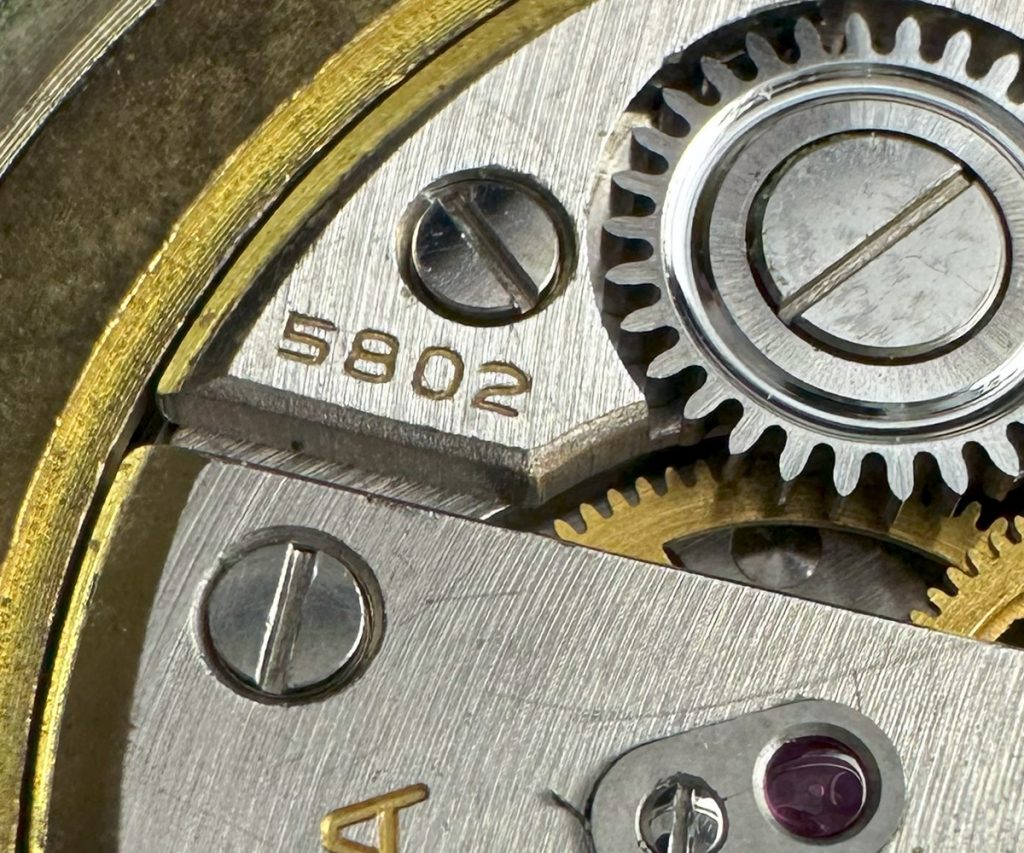
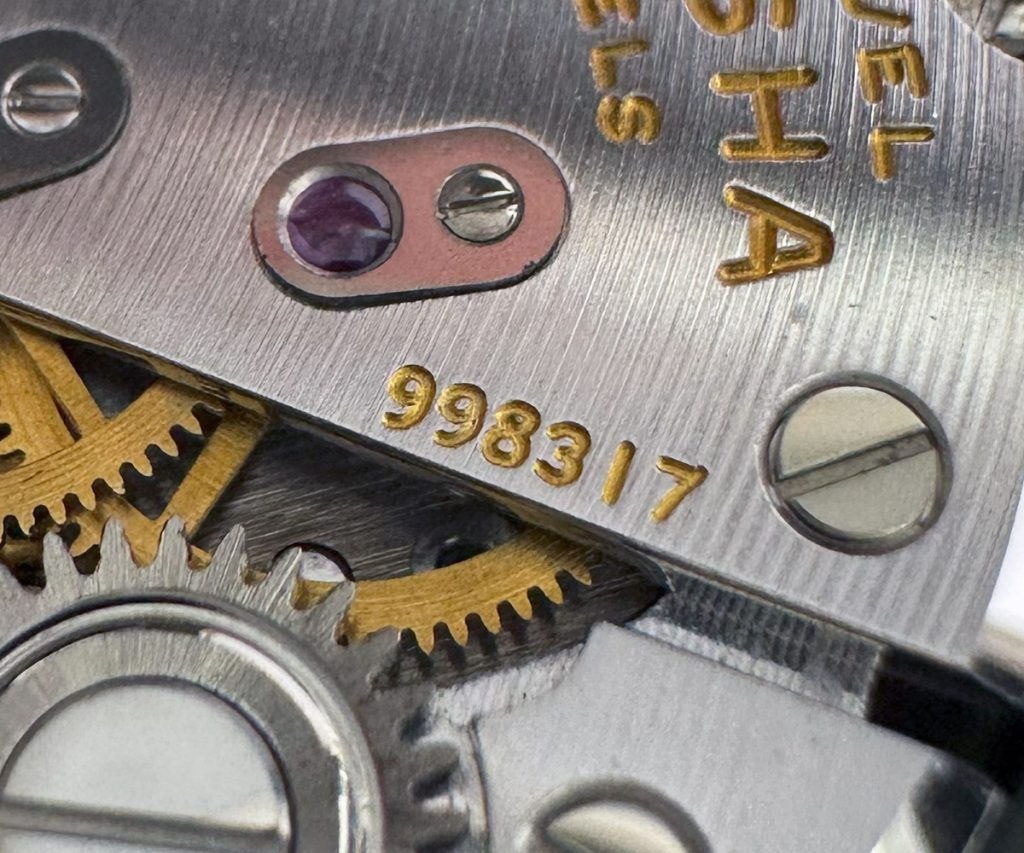
The DiaShock Shock Protection System
In 1958, a few months before the launch of the Lord Marvel, Seiko introduced DiaShock, a proprietary shock protection system designed to better protect the balance wheel from impacts.
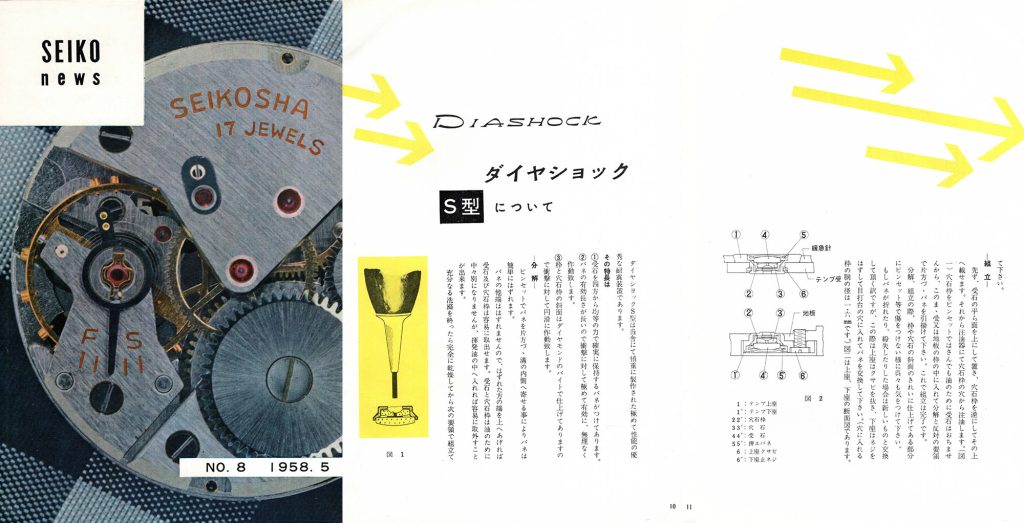
“The DiaShock shock protection device is an excellently performing mechanism, meticulously crafted by our company. Its main features include:
- A spring that securely holds the jewel bearing with uniform force from all sides.
- Significant effective spring length, ensuring excellent shock response and smooth operation.
- Mounting surfaces and pierced jewel support finished with diamond tools, allowing fluid movement even during impacts.”
This first version, commonly referred to as DiaShock S-1, is present in all Lord Marvel movements from the initial production batches.
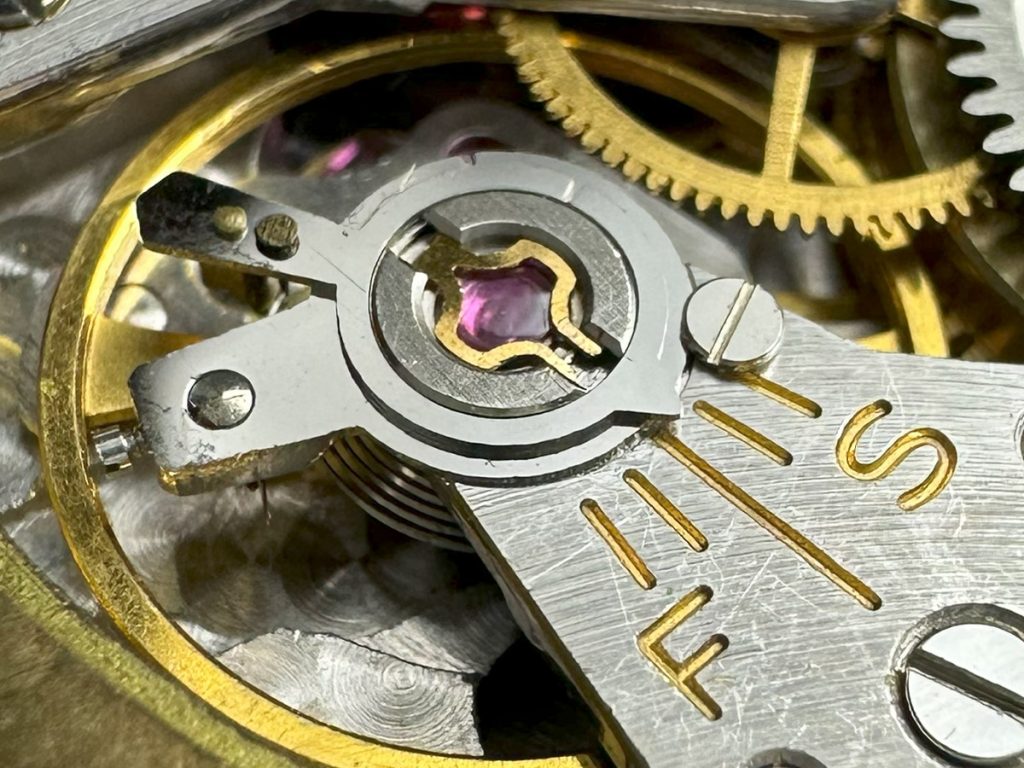
Seven months after the introduction of the S-1 DiaShock, Seiko released a new version known as S-2, described in the December 1958 issue of Seiko News.
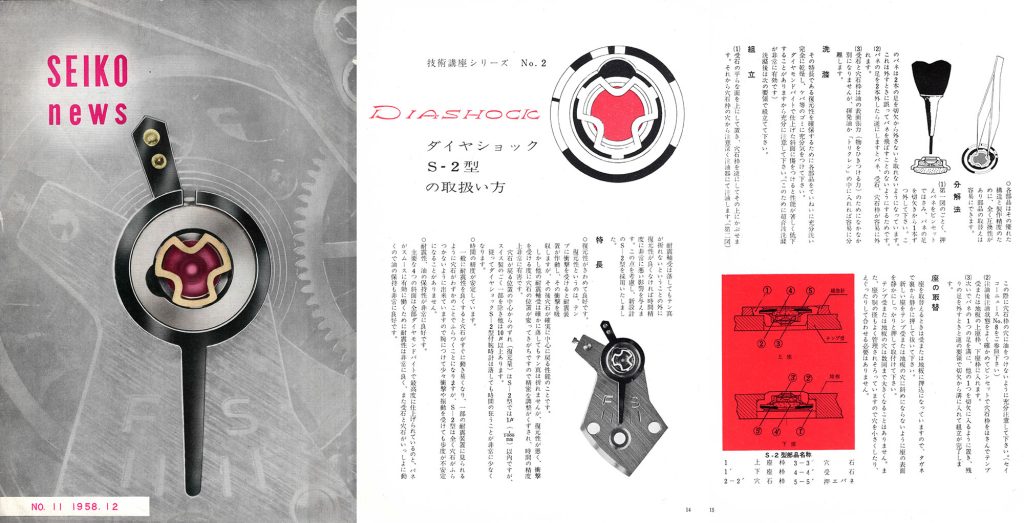
“Shock-proof devices do not simply prevent the balance pivot from breaking if the watch is dropped; they also require excellent “restoring ability” to return the jewel to its original position. If this is not achieved, the watch’s accuracy can be severely compromised. Bearing this in mind, we have adopted the new S-2 model.
Features:
Excellent restoring ability
Restoring ability refers to how effectively a shock-proof device absorbs an impact on the balance wheel and then reliably brings the hole jewel back to the center of its original position.
Although other shock-proof devices may keep the balance pivot from breaking in a drop, their restoring ability is often poor: with each impact, the hole jewel position tends to shift, gradually altering the fine regulation and compromising watch accuracy.
In the S-2 model, the deviation from the central position (the restoring margin) is less than 1 µ (1/1000 mm). Except for a few very rare Swiss-made devices, others exceed 10 µ.
As a result, watches equipped with DiaShock S-2 have minimal changes in rate even if dropped.
Stable timekeeping accuracy
Generally, improving shock resistance can make the hole jewel more prone to easy displacement, causing slight oscillations. Some shock-proof devices do exhibit this issue.
However, the S-2 model is designed to prevent any oscillation of the hole jewel, so the watch maintains stable operation even when worn daily and subjected to minor impacts and vibrations.
Excellent shock resistance and superior oil retention
The four main inclined surfaces are completely finished with diamond tools, achieving the highest level of precision. Additionally, the spring operates extremely smoothly and efficiently, granting exceptional shock resistance. Because the cap jewel and hole jewel move together, oil retention is significantly improved.
Full parts interchangeability
Due to the advanced structure and high-precision manufacturing, all parts exhibit excellent interchangeability, making component replacement much easier.”
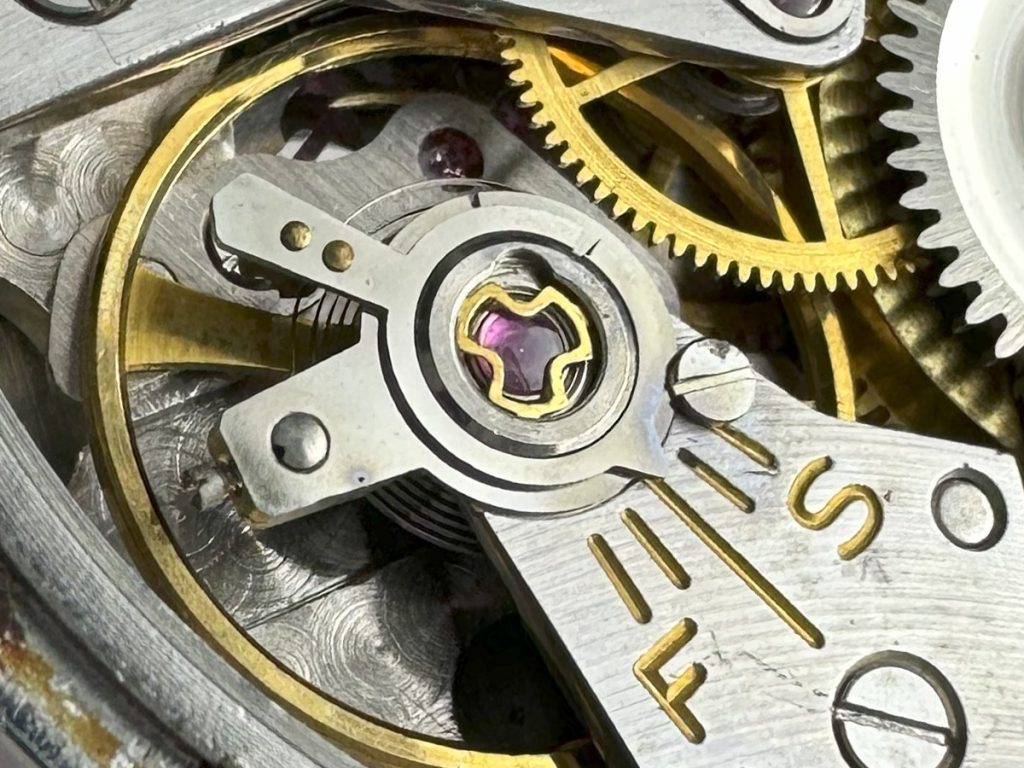
Since the S-1 type DiaShock was in use for a relatively short period before it was replaced by the new version, there are many more movements featuring the S-2 DiaShock.
Over time, the characteristic fixing screw for the balance-spring adjustment disappeared, as shown in the following photo.
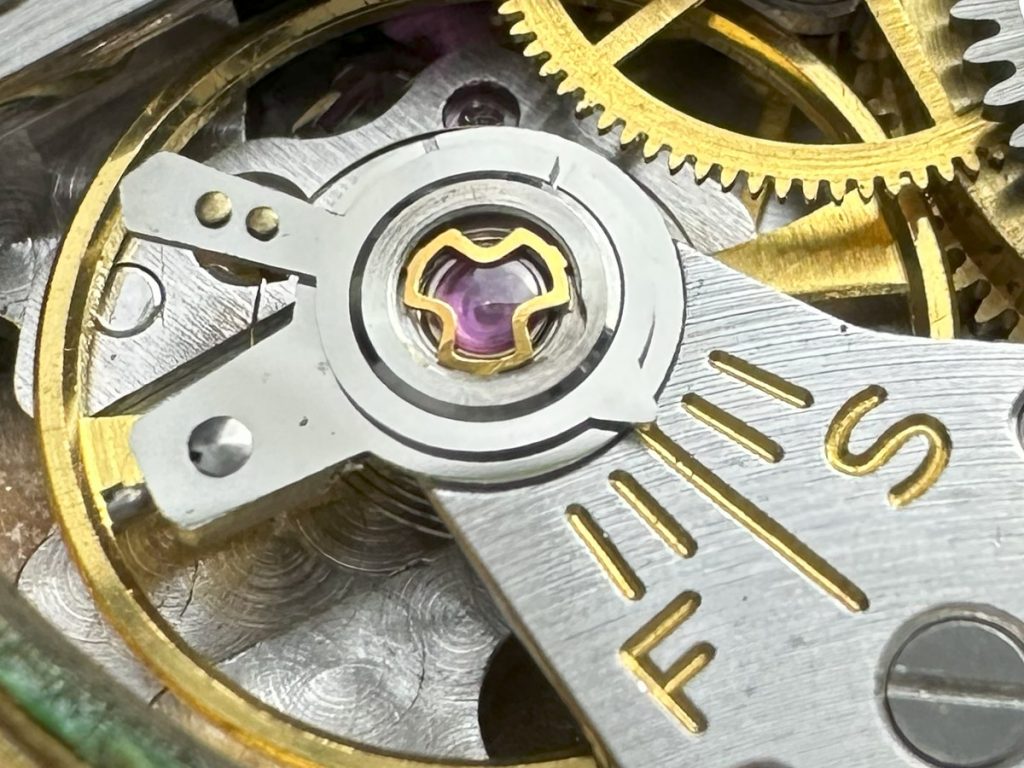
Technical Specifications and Parts List of the Movement
Below are the technical details of the Lord Marvel movement from official Seiko documentation, along with the complete parts list.
Seiko Lord Marvel (LM)
23 jewels
Diameter: 25.60 mm
Thickness: 4.40 mm
Vibrations/hour: 18,000
Hand-wound movement with three central hands
DiaShock shock protection
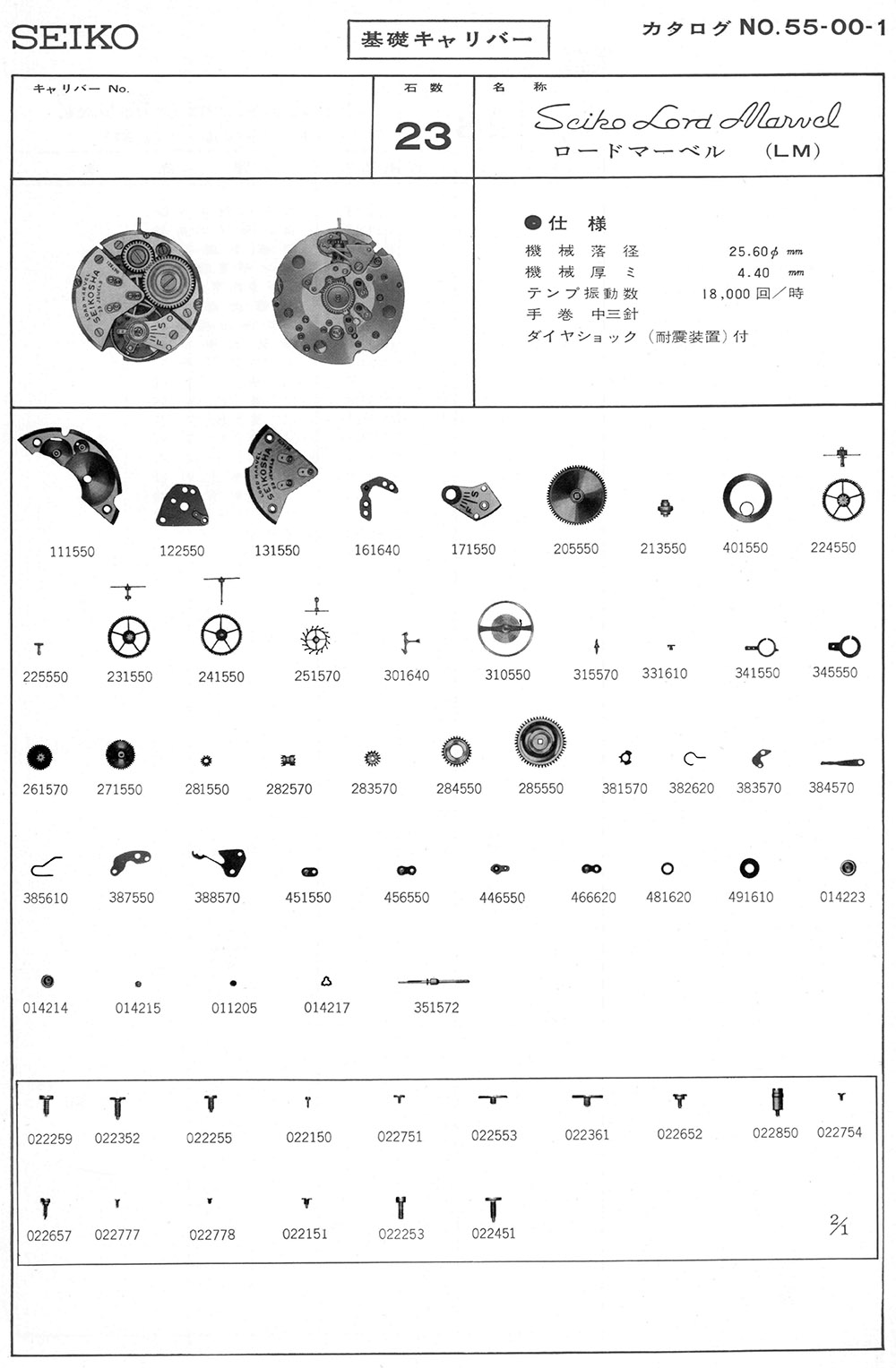
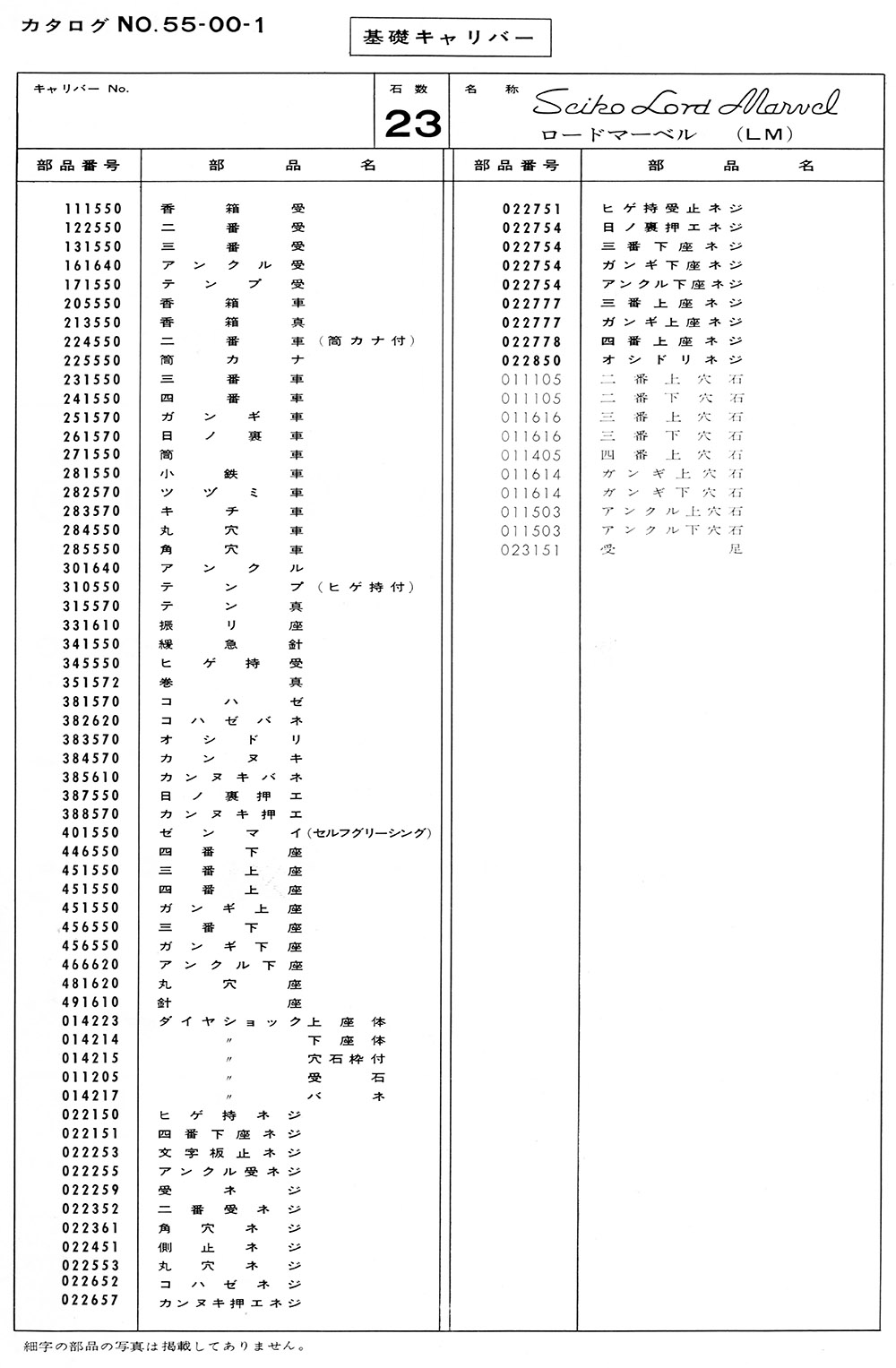
An Extremely Accurate Movement
The Lord Marvel built a reputation as a highly precise mechanical watch, surpassing not only domestic Japanese products of the time but much of the Swiss competition as well.
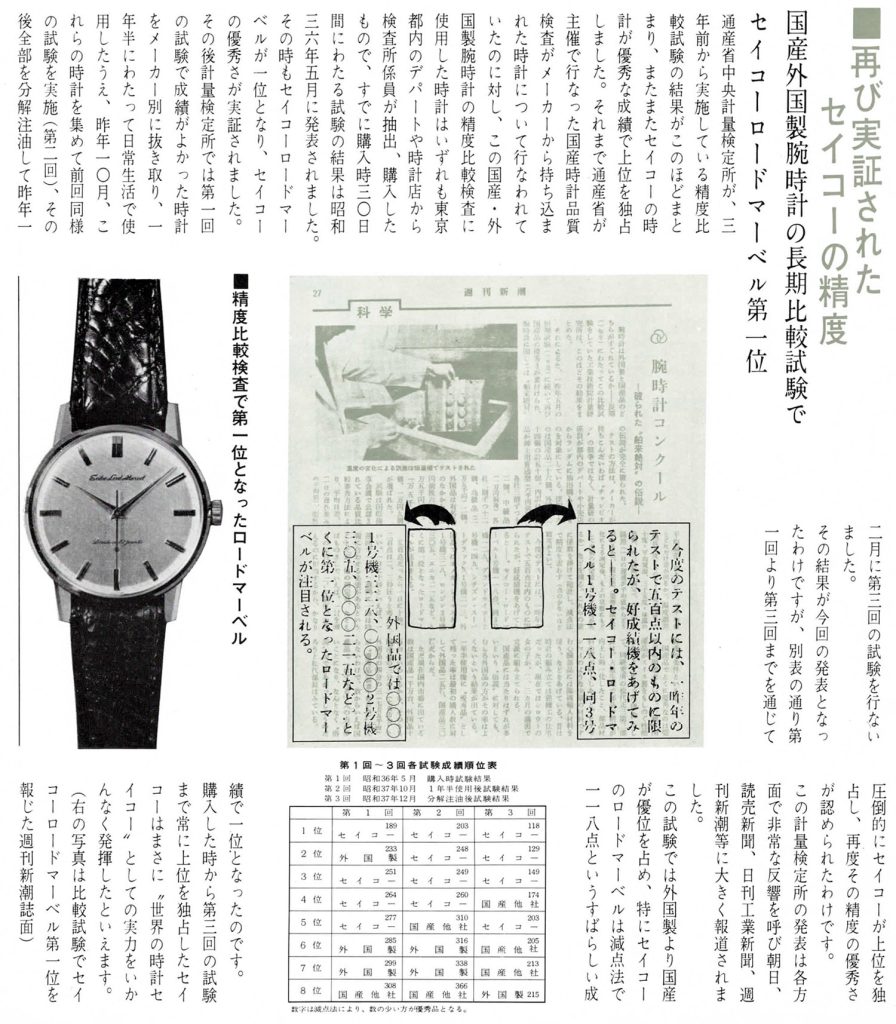
“The results of the comparative accuracy test that the Central Metrology Institute of the Ministry of Industry and Commerce conducted over a one-year period have just been published. Once again, Seiko watches dominated the top positions with outstanding results.
While in the past, the ministry’s national quality tests relied on watches supplied by manufacturers, for this comparative accuracy test—pitting domestic and foreign models against each other—the institute’s inspectors selected and purchased all the watches from department stores and watch retailers in Tokyo. The results of a 30-day test after purchase were published back in May 1961 (Showa 36).
Even then, the Seiko Lord Marvel took first place, demonstrating Seiko’s excellence.
Afterward, at the Metrology Institute, the watches that performed well in the first test were selected per manufacturer and used in daily life for a year and a half. In October of last year, these watches were collected and subjected to the same test (second round). Subsequently, they were all disassembled and lubricated, and a third test was conducted in December of last year.
The results have now been announced, and as shown in the attached table, from the first through the third test, Seiko clearly dominated the top positions, reaffirming its superior accuracy.
The announcement by this Metrology Institute generated widespread interest in various sectors and was extensively covered by Asahi, Yomiuri Shimbun, Nikkan Kogyo Shimbun, Shukan Shincho, and others.
In this test, domestic products outperformed foreign ones, and notably, the Seiko Lord Marvel achieved first place with an impressive score of 118 points according to the subtraction method.”
Boxes and Complete Sets
Over time, the Lord Marvel was sold with a variety of boxes and custom sets, and piecing together their exact chronological order is challenging.
Below are just a few examples from watches sold at auction over the past few years, arranged in what I believe to be roughly the order from earliest to latest.
